Don't wanna be here? Send us removal request.
Text
93. Intermission or how what happened to Shane Dronnett...
CTE or chronic traumatic encephalopathy and particularly how it affected Shane Dronnett has been the elephant in the room since I started writing this alternate history of the USFL.
My “writing fuel” has been the idea that having a second strong pro football league would allow basically twice as many people the opportunity to live their dream of being a professional football player. Rather than 2% of every college class of football players playing in the NFL, you’d see 4-5% going to the NFL and the USFL. I think when you read this history you see how close the USFL probably was to making this a reality and just how many people would have had hundreds of thousands of dollars injected into their families lives and a lifetime of treasured memories....It all sounds so good...until you get into a discussion of CTE.
Then it feels a little like I am advocating feeding more gladiators to the lions for my amusement.
It was tough writing about Junior Seau, a very public victim of CTE, potentially opting to play in the USFL.
The Shane Dronnett situation brought all of this to a head for me.
Shane Dronnett was a defensive end for the University of Texas in the early 1990′s. I started college at UT in 1989. I watched and cheered for Shane Dronnett. He was my second favorite on a UNT defensive line that was borderline dominant. (Sorry Tommy Jeter, James Patton, an undersized DT whose NFL career was derailed by the Buffalo curse and injuries, was my boy.)
Dronnett was the media sweetheart. He was the photo op star and the all-american player in college. He was capable of winning the battle in the run or passing game against anyone, but to my taste was not as consistent as you’d like to see out of a true all-american, but still I was very enthusiastic about his pro chances as a strongside 4-3 defensive end. If he could land in such a situation, I could see him becoming a 10 year solid starter. Maybe a Jim Jeffcoat, Greg Ellis level player...
He would end up playing most of his pro career as an undersized 3-4 defensive end. This would (probably) shorten his career. He committed suicide and was found to have had CTE.
It has saddened me every time I think of him and his family.
This story ties into my life and my love of football.
I stopped playing football in High School in 1988 after I had a concussion in a game. I had had a major concussion in practice after begging to coaches to let me play scout team nose tackle (I was 6-4 180 in high school) earlier that season. It had gone undiagnosed and had played through that in practice with my head screaming in pain. After the second concussion, I think somewhere inside me I realized that as much as I passionately loved playing football, that I was screwing myself up.
I think that decision was justified. I literally have felt brain damaged for decades now. I am still smart, but I feel like my brain worked better when I was 16. (...Now 2 years of an abusive relationship with alcohol in high school may have also played a role...) I have little things I just suck at now that I didn’t used to suck at. My memory is garbage about a lot of things. I score well on IQ tests on everything except processing speed. I recently took some tests for grad school and was absolutely abysmal on extracting the main point of articles...all very bizarre stuff for me.
I can’t help but wonder if I was on the same path Shane Dronnett took (not the All-American and future pro football player path).
It has haunted me for the first half of writing this history and when I reached the 1992 draft where he was picked I had to stop for a while and deal with this.
I don’t write this to say, “Feed this players to the lions.” I write this to say, “I loved the USFL, It could and should have made it, and all of these people were legitimately good enough to have long productive pro football careers but were fed to a the NFL profit meat grinder.”
As I wrote in this blog, I think the USFL would have realized the competitive advantage they had in going with a shorter season. My personal belief is that eventually the NFL would have followed suit and you would see a lot less of these horrible stories as the players had more time to heal. But I could be wrong. Maybe there would be no effect.
CTE paints a scary picture of how fragile our minds are when we experience even one bad collision. It calls the entire logic of playing a contact sport into question and I will confess has severely diminished my day to day enjoyment of the sport as I worry about the health of it’s players.
But I still love the USFL and writing this project, so with no disrespect to anyone who is suffering with CTE, I am going to continue. I want to continue to try to praise those forgotten players who didn’t get a real shot because of narrow minded NFL thinking.
Click here for previous post
0 notes
Text
92. The 1991 season
The arrival of the 1991 USFL season was viewed with a fair bit of trepidation by many USFL fans and scorn by many media critics, both of which felt the league had expanded too quickly. Like Carolina, Albuquerque in particular seemed suspect as a site and the media took the league to task over their “rampant expansion”.
Would Carolina implode? Would Albuquerque struggle at the gate? Sacramento and Portland looked like “at risk” teams...How could the league put another team in Washington, especially with all that in mind? Did they learn nothing last time?
Questions like, “How would Tom Landry do in year two?” and “How would Steve Young do in the Run and Shoot?” were left to the really hard core USFL fans.
Final regular season standings
Attendance would be strong in 1991 as local rivalries would help.

Team by team breakdowns

The Breakers would again take the division behind a very efficient offense that excelled at the end of games and a very solid defense.
QB Steve Young and RB Freeman McNeil would explode in the Run And Shoot. Young, previously considered a dangerous scrambler and a merely a solid passer, would change a lot of minds with host of dangerous weapons to throw to in WRs Rob Moore, Rocket Ismail, Marc Lewis, and Vincent White. McNeil would show dynamic ability running for 1200 yards. When questioned by the New York Media about his USFL success, McNeil would maintain that the Jets never just let him run.
New Jersey would tie the Breakers and Generals for the division lead but would finish 3rd due to tie breakers.
Expansion New England’s 2nd year QB Mike Buck would flash talent, but not enough to overcome a roster with several holes.

The Stars would emerge as the team to beat in the Atlantic Division. QB Todd Blackledge would show continued improvement.
Rookie QB Brett Farve would prove to be a live wire at QB and an appropriate spark for one of the league’s most loaded offenses. The emergence of rookie TE Shannon Sharpe would make the team’s offense very tough to stop. The raw Farve’s unwillingness to give up on plays however would lead to too many interceptions, costing the team in several games. An ill-timed pick 6 in the season final would give the division to the Stars.
The Federals would have the division lead with 3 games remaining in a successful first season before ending the season on a 3 game skid after featured RB Curtis Bledsoe went down with an injury. Herman Moore would emerge as the league’s most dangerous receiver opposite Perry Tuttle and Don Majkowski would show he still had a knack for winning games late.
Baltimore would also suffer a rough end to the season, but the emergence of rookie WR Jeff Graham as a 1000 yard receiver would give fans hope for a brighter future.

The arrival of rookie WRs Randall Hill and Lawrence Dawsey would revitalize the Bandit offense. Tampa would go 5-1 in division and run away with the title.
After a rough start, Browning Nagle would improve as the season progressed. The Spirits defense would carry the team into the playoffs.
Orlando would be in each game due to the relentless running of RB Emmitt Smith and the clutch play of QB Steve Walsh, but the team still appeared solid more than good. There was a perception that their time was still a couple years away.
The loss of WR Perry Kemp in week 10 would hobble the potent Bulls offense and cost the team a shot at the playoffs.

Despite lingering injuries to RB John Stephens and QB Warren Moon, the Showboat offensive machine would continue to chug along. The team would take the division soundly.
QB Walter Lewis would recover his old magic in carrying the Tribe into the playoffs for the first time. The arrival of LB Kurt Crain from Birmingham would trigger a dramatic improvement on the defense.
To make new QB Gary Hogeboom comfortable, Charlie Pell would remodel his offense to mirror Norv Turner’s. Hogeboom would respond with a very solid season, finally resolving Birmingham’s longstanding QB problem. Pell would move Crain in order to shift to a 4-3 defense without push back from the fans and Stallions’s front office. MLB Keith McCants would have a breakout year in the new set.
Tommy Hodson would be significantly better in his first year under Coach Archie Manning. With improved pass protection, Hodson began to properly adjust to speed of the pro game. The team’s promotional media would feature star RB Marcus Dupree when he passed Hershel Walker to become the league’s all time leasing rusher in week three but it would prove to be Dupree’s last season in the USFL as father time rapidly caught up to elite runner....Former Grambling star RB Walter Dean would emerge as the team’s new featured back in the season’s last 5 games.

Al Saunders’ Maulers team would finally win a division title behind a loaded defense and the leadership and running of 2nd year QB Major Harris.
The Blitz offense and defense were among the league’s best, but two losses to the Maulers would cost the team the division.
The Monte Clark’s Panthers would begin to emerge on offense and the team’s defense, reinforced by members of George Perles’s Michigan State defense, would quickly become known as the league’s hardest hitting unit.
The Visogoths would play well, but, in a loaded division, wins would be hard to come by.

Jim Kelly’s Gamblers would be in a dogfight with Tom Landry’s San Antonio Gunslingers for the division title, but a decisive 31-17 win in the week 14 season finale rivalry matchup would give the Gamblers the division.
QB Steve Pelleur’s ability to do what previous Gunbslinger QBs could not do and throw all of the passes with consistency would bring the Gunslinger’s loaded and speedy offense to life.
QB Doug Williams would again miss most of the Outlaws’s season due to injuries. RB Thurman Thomas would blossom into an all-league performer, but Oklahoma would fall off previous years.
While they would only win 4 games, Coach Craig Morton’s expansion Chupacabras would be in every game with a solid defense and an above average offense. They would draw well for a sub .500 expansion team.

Vinny Testaverde would break all Express single season passing records as LA ran away with the division early and cruised into the playoffs. WR Reggie Rembert would would rival DC’s Herman Moore as the league’s most difficult receiver to cover.
WR Ed McCaffrey would push Gordon Banks and Ken Margerum down the pecking order. The tall, sure handed McCaffrey would give Coach George Allen’s offense yet another short yardage/end zone threat.
WR Jackie Flowers would have a great season after Jim Sandusky was lost for 6 weeks, but injuries to key players (QB Alan Risher, Rookie RB Leonard Russell) and defections to the NFL would hobble the Wranglers.
The transition to a more run oriented offense and influx of more former Denver Bronchos and Colorado Buffaloes players would be a mixed bag. The team would have no trouble establishing their running game with the lightning and thunder combination of RB Eric Bienemy and FB Bill Johnson on most opponents and their trio of WRs (Frank Lockett, Aaron Cox, and Mike Pritchard) could blow open the top of almost any defense. Their defense lead by LBs Alfred Williams, Kanavis McGhee, and John Nevins would be quite good. The fans would love the remodel but the record would be disappointing. QB Marc Wilson would flash good play but would constantly miss receivers and disappoint the staff. QB Scott Mitchell would start the last 3 games.

QB Robbie Bosco would run a very consistent and efficient ball control offense that played off the running of rookie big play threat RB Aaron Craver.
QB David Woodley would shock the league. Known as “The Guy Dan Marino Replaced In Miami”, Woodley would demonstrate solid passing skills, great mobility, and an advanced knowledge of the game. Despite an often overwhelmed defense, two heartbreaking losses to The Hawaiians by a total of 6 points would be all that separated the expansion Tree Huggers from the playoffs.
David Archer would begin to recover his best NFL form in season 2 in Sacramento. The team’s strong running game would help.
Portland’s season was undone when Gary Hogeboom forced his way out. QB Steve Beurlein was unprepared to start and made few plays playing behind a porous line. After a 1-7 start, Norv Turner figured sticking with Beurlein would just put his job at risk, so rookie QB Dan McGuire was inserted into the starting lineup along with rookie RB Blaise Bryant. With a half season on the bench to adjust to the speed of the league and an offense that largely just wanted him to sit in the pocket and throw slant routes, McGuire looked fairly good in the last month or so of the season. Portland’s defense was fairly strong throughout the season.
Playoffs
Wild Card Weekend
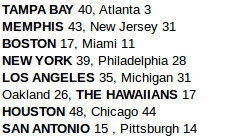
Eastern #1 Seed Tampa Bay would destroy the #8 Seed Atlanta Tribe in Tampa behind a spotless day by QB Chuck Long and an inspired Bandits defensive effort.
The #2 seed Memphis Showboats would struggle with New Jersey RB Barry Sanders giving up 212 yards and 4 TDs, but an early pick 6 on QB Don McPherson would have #7 Knights down 14-0 and playing catch-up all day.
In a match up of teams with strong defenses, QB play would decide the game with Boston all-star QB Doug Flutie leading his #3 seed Breakers to TDs while Miami Rookie Browning Nagle could only lead his #6 Seed Spirits to field goals.
Philadelphia fans would be angered by the new rule that the team with the best record hosted the playoff the game. Their #4 seed Atlantic Division Champion Stars who had beaten the #5 Seed New York Generals soundly in the Season’s second week, 26-12, had to play at Trump Stadium in New York due to winning one fewer regular season game than New York. They faced a different Steve Young in the playoffs. Young masterfully ripped up the Stars defense, throwing for 375 yards and 3 TDs. Freeman McNeil would add another 175 yards and 3 TDs.
The western #1 seed Los Angeles Express got all they could handle from #8 seed Michigan. Vinny Testaverde had entered the playoffs white hot, throwing 10 TDs and only 1 Interception in the season’s final 3 weeks, but the Panthers would pick off Testaverde twice before LA turned to the hard running of RB Christian Okoye to put the game away.
The #2 seed Hawaiians would hate the draw they got for the playoffs. #7 Seed Oakland just matched up very well with the Hawaiians, having beaten them 30-12 in Hawaii in week 10. George Allen’s team would do it again, bottling up rookie RB sensation Aaron Craver.
The weekend’s feature game would pit Jim Kelly’s #3 seed Houston Gamblers against Bo Jackson’s #6 seed Chicago Blitz. The game would live up to the advanced billing with Jackson running for 245 yards and 5 TDs and Kelly throwing for 350 yards and 4 TDs.
The #4 seed Pittsburgh Maulers would also lose their home field advantage due to the league’s new playoff rules. The #5 San Antonio Gunslingers would find Pittsburgh’s defense impenetrable, but the solid veteran leadership of Steve Pelleur would keep the team from panicking and in position to kick a last second 49 yard field goal to win the game.
Divisional Round

The Bandits/Generals matchup was another great battle between the long-time rival teams with Chuck Long erasing a furious 17 point fourth quarter comeback by General QB Steve Young that had put the Generals up 41-40 with 3:13 seconds to go. Long would surgically drive his team down the field the eating up 3:05 before hitting Rookie WR Lawrence Dawsey for the game winning TD. Generals RB Freeman McNeil would score another 3 TDs.
The Memphis Showboats/Boston Breakers game would be a rematch of the previous season’s eastern conference final with Warren Moon’s Showboats winning the coin flip in overtime and kicking a 41 yard FG to eliminate the Breakers.
Vinny Testaverde would bounce back and have a solid game as Los Angeles would eliminate the Gunslingers.
No one would expect the results of the Houston Gamblers/Oakland Invaders game. The Gamblers would take out years of playoff frustration on their longtime western conference nemesis. The Invaders defense would severely slow the Gamblers offense but the Gamblers defense, called out by head coach Jack Pardee, took their game to another level after struggling against Chicago the previous week.
The conference round

Warren Moon’s Showboats would win a back and forth dogfight with Chuck Long’s Bandits. The game would be decided on a 35 yard FG with 12 seconds to play.
Houston would take a 24-7 lead into the half. QB Vinny Testaverde would again struggle. He had a first half TD but also threw a pick six. LA coach Don Coryell would shuffle the deck at halftime, bringing out rookie QB Todd Marinovich. Marinovich would play a spotless second half throwing for 247 yards 3 TDs and 0 Interceptions and getting the Express back into the game, but Houston would hang on to win.
Championship game

The matchup between Jim Kelly and Warren Moon would do something none of the original owners would have thought possible after the league’s initial season...It would sell out Chicago’s Soldier Field for a playoff game at full price tickets. The game would set new USFL championship game viewership numbers.
After two straight dogfights, it would become quickly apparent in the championship game that emotionally, the Showboats were exhausted. Houston would run out to an early 21-3 lead and Jim Kelly would keep his foot on the gas all game, preventing Warren Moon from dragging the Showboats back into the game.
Kelly would become the league’s second two time championship game MVP.

1 note
·
View note
Text
91. The 1991 season --- Team rosters
Team by team breakdown of more noted players in the 1991 season.
Atlanta - QB Walter Lewis, QB Rodney Peete, RB Cleveland Gary, RB Vagus Ferguson, FB Ken Talton, WR Marcus Anderson, WR/KR Cormac Carney,TE Ken Wisenhunt, DE Curtis Anderson, DE/DT Jackie Cline DE/DT Jimmy Walker DL Kevin Middleton OLB Cornelius Bennett, OLB Aundrey Bruce ILB John Brantley, ILB Kurt Crain FS Riccardo Ingram SS Bubba McDowell P Jim Grupp K Efren Herrera
Arizona- QB Alan Risher, QB Todd Santos RB Leonard Russell, RB Kevin Nelson, RB Randy Johnson RB John Barnett,FB Mack Boatner, WR Jim Sandusky, WR Jackie Flowers, TE Mark Keel, G Randall McDaniel G Carl Roberts G Frank Kalil, C Mike Katolin OL Jeff Kiewel RG Alvin Powell, DE Skip McLendon, DE Mike Mraz DT Stan Mataele NT Dan Saleamua NT Dave Futrell OLB Ben Apuna, OLB Scott Stephen MLB Byron Evans CB Anthony Parker DB Lance Shields DB Eddie Brown DB Gordon Bunch,FS Allen Durden FS Nathan LaDuke SS/OLB David Fulcher SS Chuck Cecil SS Don Schwartz P/K Frank Corral
Baltimore- QB Rick Neuheisel, QB Mike Shula, WR Jeff Graham WR Joey Walters, TE victor Hicks, RB Chris Warren, RB Harry Sydney, DE Mike Fox, DE Willie Broughton,DT Eric Swann DT Bob Nelson DT Wally Klein,
Birmingham- QB Gary Hogeboom,QB Kerwin Bell, RB Brent Fullwood, RB Jerry Mays, RB Scott Stamper FB Tommie Agee WR Wendell Davis, WR Joey Jones, WR Ron Fredrick, WR Greg Richardson TE Darryl Mason TE Allama Matthews T Antoine Davis T Pat Phenix, T Robert Woods G Crawford Ker G Pat Saindon, G Buddy Aydelette, C Tom Banks G Dave Drechsler DE Jon Hand DE Tracy Rocker,DE/DT Ronnie Paggett, DT David Rocker DT Doug Smith, NT Benji Roland OLB Herb Spencer,LB Dallas Hickman, LB Thomas Boyd MLB Keith McCants CB Ricky Ray CB Dennis Woodberry CB Frank Reed SS Billy Cesare FS Mike Thomas SS Chuck Clanton P Danny Miller K Phillip Doyle
Boston - QB Doug Flutie, QB Shawn Halloran, RB Jaime Morris,RB Troy Stradford, WR Kelvin Martin, WR Darren Flutie, WR Tom Waddle, TE Mike Bitterman, T Dave Widell T Scott Hough, T Pat Staub G Joe Wolf G Steve Trapillo G John Schmeding C Mike McLaughlin DE John Bosa,DE Kenny Neil DE Robert Banks DL Justin Strzelcyzk, NT Mike Ruth OLB Ben Needham OLB Bill Romanowski,ILB Marcus Marek ILB Michael Stonebreaker, ILB Ned Bolcar CB Gordie Lockbaum CB Woorow Wilson S Joe Restic S Pat Eilers S Stan Smagala DB D'Jaun Francisco P Bucky Scribner K John Carney
Carolina - QB Bret Farve,QB Ben Bennett WR Clarkston Hines, WR Sterling Sharpe, WR Naz Worthen, WR Robert Clark TE Shannon Sharp, RB Kevin Mack,RB Derrick Fenner, G Stacy Long G John Schmeding G Gerry Raymond DE Ray Agnew, DE Malcolm Taylor, DT Micheal Dean Perry, NT Roy Hart,DT Vance Hammond, OLB Vinson Smith, CB Donnell Woolford,CB Wayne Haddix,CB Joe Johnson,S Brad Edwards,K Steve Christie
Chicago-QB Jack Trudeau, QB Chuck Hartlieb, RB Bo Jackson, RB Thomas Rooks, FB Keith Byars, FB Howard Griffith WR David Williams,WR/KR Tim Brown, WR Doug Donely, TE Cap Boso, TE Jerry Reese LT Mark Dennis, LT Lee Spivey,LT Duane Wilson,G Jim Juriga,RG Arland Thompson, C Bill Winters DE Tyrone Keys, DE Scott Davis, DT Don Thorp, DT Moe Gardner, DT Mel Agee, NT Paul Hanna DT Tony Suber ILB Pepper Johnson MLB Darrick Brownlow, ILB Jeff Leiding LB Byron Lee LB Scott Leach LB Larry Kolic CB Rod Hill, CB Vince Buck, CB Kerry Glenn, FS Craig Swoope S Henry Jones S Sonny Gordon P Jim Miller K Max Zendejas
Denver- QB Marc Wilson,QB Scott Mitchell RB Eric Bienemy RB Steve Bartalo FB Bill Johnson, WR Frank Lockett,WR Mike Pritchard, WR Aaron Cox, RT Mark Vander Poel, LT Steve Rogers, G Ariel Solomon C Joe Garten C Tom Davis OL Sid Abramowitz DE Calvin Turner, DE Kenny Walker DL Chad Hennings,NT Tim Moore, OLB Alfred Williams, OLB Kanavais McGhee, ILB Galand Thaxton ILB John Nevens, LB Greg Gerken CB Dave McCloughan CB David Dumars CB Nate Miller, CB Victor Scott SS Mickey Pruitt, P Jack Weil K/P Jim Asmus
District of Columbia - QB Don Majkowski QB Shawn Moore RB Curtis Bledsoe, WR Herman Moore WR Perry Tuttle, RT Eric Williams, LT Dean Miraldi NT Chris Zorich K Chris Gardocki
Hawaii - QB Jack Thompson, QB Robbie Bosco,QB Garrett Gabriel, WR Walter Murray, WR Mark Bellini , WR Glen Kozlowski, RB Aaron Craver, RB/PR/KR Gary Allen, RB Anthony Edgar RB/PR/KR Vai Sikahema, FB Lakei Heimuli, FB Tom Tuipulotu, TE Trevor Molini, TE David Mills, RT Jim Mills LT Darryl Haley, T Neal Fort T Vince Stroth, T Nick Eyre, T Wayne Faalafua G Joe Onosai G Louis Wong G Bernard Carvalho, C Kani Kauahi, C Ed Riewerts C Robert Anae DE Al Noga DE Jason Buck DE Jim Herrmann DE Brandon Flint DE Brad Anae, DE Junior Filiaga, DT Kit Lathrop DT Tom Tuinei DT Colin Scotts, DT Brad Smith, OLB Kyle Whittigham, OLB Leon White, LB Cary Whittingham, MLB Kurt Gouveia,MLB Marv Allen LB Niko Noga CB Brian Mitchell CB Dana McLemore CB Jeff Griffin CB Manny Hendrix, CB Rodney Thomas, DB Rodney Rice, DB Kent Kafentzis, FS Blaine Gaison FS Jeff Wilcox FS Rich Miano SS Mark Kafentzis SS Kyle Morrell SS Jeff Sprowls, S Verlon Redd S Troy Long P/TE Clay Brown K Paul Woodside
Houston- QB Jim Kelly, QB Andre Ware WR Richard Johnson, WR Ricky Sanders, WR/PR Gerald McNeil, WR/KR Clarence Verdin, wr Manny Hazard RB Ickey Woods, RB Darren Lewis RB Todd Fowler, RB Chuck Weatherspoon RB Darryl Clark, LT Bryan Dausin RT Tommy Robinson T Ernie Rogers, T Denver Johnson RG Billy Kidd, LG Scott Boucher, C Mike Arthur C Frank Kalil, DE Pete Catan, DE Cleveland Crosby DE Charles Benson DT Craig Veasey, DT Tony Fitzpatrick DT Hosea Taylor OLB Andy Hawkins, OLB Mike Hawkins, MLB Kiki DeAyala, LB Lamar Lathon, CB Audrey McMillan, CB Will Lewis CB Mike Mitchell FS Luther Bradley FS Hollis Hall SS Steve Atwater SS Calvin Eason,S Tommy Myers P Dale Walters K Roman Anderson
Jacksonville- QB Ed Luther, QB Robbie Mahfouz QB Craig Erickson WR Wesley Carroll WR Alton Alexis, WR Perry Kemp, WR Wyatt Henderson RB Gaston Green KR/RB Tony Boddie, FB Larry Mason FB Melvin Bratton, T Bob Gruber G George Collins C Jay Pennison T Roy simmons C Mike Reuther,RT Ralph Williams, LG Rich garza,DE Anthony Smith, DE Alphonso Carreker, DE Keith Millard, DE Phil Dokes OLB Roman Pfifer WLB Maurice Crum LB Kirk Carruthers OLB tom dinkle OLB Joe Castillo, MLB Bernard Clark, CB Terry McDaniel, CB Van Jakes DB Will White S Don Bessillieu S Chester Gee CB Mark Harper DB Bobby Hosea, P/K Brian Franco
Los Angeles- QB Vinny Testaverde, QB Todd Marinovich QB Doug Gaynor, RB Christian Okoye, RB Reggie Brown RB/KR Jarvis Redwine, WR Mike Sherrad, WR Reggie Rembert, WR Willie “Flipper” Anderson, WR Duane Gunn WR John Jefferson TE Tim Wrightman OL Rod Walters, Vince Stroh, Bob Simmons, Doug Hoppock, Perry Harnett, & Jerry Doerger, G Max Montoya G Mark Tucker C Mike Katolin & G Alvin Powell, C Mike Schad, DE Gary Jeter,DE Lee Williams, DT George Achica, DE Fletcher Jenkins, DE Ben Rudolph DT Eddie Weaver,DE Dennis Edwards, DE Ray Cattage, DE Rich Dimler OLB Ken Norton Jr., OLB Eric Scoggins,LB Scott Ross MLB Marvcus Patton LB Danny Rich LB Sam Norris CB Darryl Henley CB Wymon Henderson, CB John Hendy CB Tyrone Justin FS/CB Mike Fox SS Tim McDonald P Jeff Partridge K Tony Zendejas,
Memphis- QB Warren Moon, QB Whit Taylor, QB Jeff Francis, WR Derek Holloway WR/KR Derrick Crawford, WR Greg Moser, WR Alexander Wright, WR Anthony Morgan WR Sam Graddy, WR Ted Wilson, WR Gizmo Williams RB John Stephens FB Cornelius Quarles, TE Keli McGregor T Richard Cooper, RG Myke Horton G Bill Mayo DE Anthony Pleasant, DE Calvin Clark DT Reggie White, OLB Kenny Tippins OLB Tony Hill LB Rod Shoate, LB Mike Brewington MLB Chris Gaines CB Mossy Cade CB Leonard Coleman CB mike thomas DB Terry Love FS Vic Minor SS Barney Bussey P Jimmy Colquitt K Alan Duncan
Miami – QB Browning Nagle, QB Peter Tom Willis RB Rodney Hampton, RB/PR/KR Eric Robinson FB Dwayne Crutchfield, WR Michael Irvin, WR Eddie Brown, WR/KR Mike Harris WR Greg Taylor, WR Ricky Simmons WR Elmer Bailey TE Willie Smith TE Bob Niziolek LT Mike Sullivan LT Joel Patten RT Jeff Seevy RT/RG Dave Pacella RG Ed Fulton C/G Brian Musselman C Tony Loia Vaughn Harman DE Ken Fagan DE Danny Stubbs ,DT Jerome Brown, DT Dan Sileo, LDT Bennie Smith OLB Winston Moss LB Jon McVeigh MLB George Mira MLB Mike Muller CB Jeff Brown CB Reggie Sutton FS Bennie Blades SS Mike Guess P Jeff Feagles K Jeff Brockhaus
Michigan – QB Jim Harbaugh, QB Jim Karasatos, RB Lorenzo White, FB Albert Bentley,WR Andre Rison, WR Chris Carter, WR Anthony Allen, TE Eric Kattus TE Duane Young,TE Mike Cobb,TE Donnie Echols T Chris Godfrey, T Ken Dallafior,G Eric Moten G Dean Dingman G Tyrone McGriff, C Wayne Radloff,C/G George Lilja, DE Al ���Bubba’ Baker,DE John Corker, DE Mark Messner, DE Matt Vanderbeek DT/NT David Tipton DT Mike Hammerstein DT/DE Allen Hughes OLB Dixon Edwards OLB Bobby Abrams, OLB Carlos Jenkins MLB Percy Snow, LB Mike Mallory, CB Clarence Chapman,CB Brad Cochran CB Vito McKeever CB Oliver Davis CB Ron Osborne FS Garland Rivers SS Harlon Barnett S/PR Tripp Welbourne P Jeff Gossett K Novo Bojovich
Milwaukee-QB John Friesz, QB Bob Lane, RB Anthony Thompson, RB Nick Bell FB Bob Christian WR/KR Mike Bellamy, WR Jaime Holland RT Jerry Crafts G Kirk Scrafford SDE Don Davey WDE Mike Flores DT Greg Feilds DT Leon Lett, DT Paul Hanna LB Melvin Foster LB Mark Sander OLB Angelo Snipes OLB Kyle Borland ILB Ray Bentley, ILB Robert Pennywell CB Steve Jackson CB Mike McGruder,FS Merton Hanks S Tim Hauk S Pat Eilers,DB Sonny Gordon, SS David Greenwood
New England - QB Mike Buck, QB Tom Ramsey, RB Robert Drummond,RB Mike Mayweather RB Judd Garrett, WR Scott Schwedes,WR John Garrett, WR Clarence Collins WR Walter Broughton WR Tom McConnaughey WR Charlie Smith, TE Brian Forster, TE Gordon Hudson, T Harry Boatswain, G Tim Ryan G Mike Brennan G Dean Brown C Tim Grunhard,ILB Larry Kolic, CB Todd Lyght,P Chris Shale
New Mexico - QB Todd Dillon, QB Bob Gagliano RB Harvey Williams,RB Eric Pegram RB Del Rodgers, WR Keenan McCardell WR Terrence Mathis WR Kerry Cash, TE Keith Cash, TE Chris Smith DE Michael Sinclair, DE Mitch Donahue,DT Chad Hennings,OLB Marcus Cotton, OLB Galand Thaxton MLB Terry Maki, CB/PR David Martin, CB Tom Rotello CB Sammy Walker, FS Scott Thomas,
New Jersey - QB Don McPherson, QB Jason Garrett, RB Barry Sanders, RB Kirby Warren,WR Leonard Harris, WR Brett Perriman, WR Bernard Ford, WR Rob Carpenter, T Jumbo Elliot, T Paul Gruber, DE Rob Burnett, LB Terry Wooden, CB vince Clark, FS Marcus Paul
New Orleans- QB Tommy Hodson,QB Clemente Gordon, QB Matt Stevens, RB Marcus Dupree, RB Walter Dean, RB Anthony Steels,WR Jake Reed WR Bobby Slaughter WR Ron Johnson WR Mardye Mcdole TE Andrew Glover LT Charles McRae T Broderick Thompson DT Jerald Bayless, DT Henry Thomas DT Jeff Gaylord, DT Larry McClain, DE Darryl Wilkerson DE Larry White NT Jerry Ball NT Oudious Lee OLB Micheal Brooks OLB Erick Krumerow KB ray phillips CB Otis Smith CB Lyndell Jones FS Greg Jackson SS Leroy Butler S Charles Harbison S Tim Smith P Dario Casarino, K Tim Mazzetti
New York - QB Steve Young, QB Tom Ehrhardt, RB Freeman McNeil RB Dwight Sullivan RB Kelvin Farmer, FB Maurice Carthon,WR Rob Carpenter,WR/KR Rocket Ismail, WR/KR Marc Lewis, WR Vincent White, G Billy Ard, C Kent Hull, DE James Lockette, DE Ray Seals, DE Ricky Williamson, DE Freddie Gilbert DT Erik Howard DT Tom Woodland, NT Ted Gregory LB Jim LeClair, LB Mike Weddington CB Kerry Justin,CB Mike Williams CB Terry Daniels S Gregg Johnson DB Tony Thurman P Rick Partridge K Roger Ruzek
Oakland- QB Mike Perez, QB John Paye, QB Troy Taylor RB Eric Jordan,RB Tim Spencer, RB/KR Elmer James FB Brad Muster WR Ed McCaffery WR Gordon Banks, WR Ken Margerum, WR Lew Barnes WR Kevin Williams, TE Eric Green, TE Brian Williams, LT Gary Zimmerman, RT Mark Treynowicz T Ricky Siglar, G Gerry Raymond,G Mickey Marvin G Tracy Franz, G Jim Leonard C Roger Levasa DE Bruce Thornton, WDE Dave Browning, SDE Greg Feilds,DE Brad Anae, DT Ted Washington DT Rhett Hall DT Monte Bennett,DE/DT Bruce Thornton,DE/NT Mark Buben DT Brad Smith, OLB Dave Wyman, OLB David Shaw OLB Tim Lucas, ILB Gary Plummer LB Tony Caldwell OLB Mark Stewart RCB Deion Sanders LCB Mark Collins,CB Derrick Martin,FS Tommy Wilcox FS Frank Duncan, SS Marcus Quinn, P Stan Talley, K Sandro Vitiello
Oklahoma – QB Doug Williams, QB Mike Gundy, RB Thurman Thomas, RB Allen Pinkett,RB Gerald Hudson RB Spencer Tillman, FB Ken Lacy, FB Ted Sample, FB Jim Stone, WR Al Williams, WR Kris Haines, WR Lonnie Turner,WR Derrick Sheppard, TE Keith Jackson, TE Ron Wheeler, LT Joe Levellis T Mike Perino, RT Jim Bob Lamb,G David Huffman, G Tom Thayer, C Brian Williams C Mark Fischer, DE Leslie O'Neal DE Bob Clasby, NT Tony Casillas, OLB Kevin Murphy ILB Britt Hager ILB Dante Jones ILB Terry Beeson, LB Vic Koenning, LB Tony Furjanic CB Larry Brown CB Peter Raeford,CB Rock Richmond, CB Barry Copeland, CB Roney McMillan CB Lee Wilson DB Rod Brown SS Herb Williams, S/PR Tim Gordon P Case DeBrujin, K Luis Zendejas
Orlando - QB Steve Walsh, QB Roy Dewalt RB Emmitt Smith, RB Buford McGee, RB Scott Stamper, RB Earl Gant, RB Nuu Faaola, FB Cedric Smith, FB LaRue Harrington FB Leon Perry TE Mike Mularky,WR Ricky Simmons WR Elmer Bailey T Ed Muransky, G Vernice Smith, DE Shane Curry DE Bill Hawkins, DE Willis Peguese, DE Bob Cobb DE/NT Richard Tharpe DT Jimmie Jones, DT Kevin Kellin DT Gurnest Brown LOLB Darnell Dailey ROLB Joe Hines MLB Paul McGowan,LB Ken Kelley CB Richard Fain CB Trent Bryant CB Willie Holley FS Victor Jackson SS Jarvis Williams P Rick Tuten & The Frozen Fifteen.
Philadelphia- QB Todd Blackledge, QB Jim Crocicchia, HB Paul Palmer, RB Allen Harvin, RB Kelvin Bryant, FB David Riley WR Hart Lee Dykes WR Scott Fitzkee, WR Willie Collier WR Tom Donovan TE Ken Dunek TE Steve Folsom RT Irv Eatman, RG Chuck Commiskey, C Bart Oates, LG George Gilbert LT Mike McClearn D Bill Dugan NT Pete Kugler, DE William Fuller, DE John Walker, DE/DT Willie Rosborough ILB Shane Conlan, ILB Glenn Howard, OLB John Bunting OLB George Cooper LB John Brooks CB Ben Smith, CB Garcia Lane CB John Sutton FS Mike Lush,SS Mike Dumas CB/S Roger Jackson P Sean Landeta, K David Trout
Pittsburgh- QB Major Harris, QB Raphel Cherry HB Mike Rozier, HB Curvin Richards HB Walter Holman,HB Reggie Taylor, RB/KR/PR Mel Grey FB Amos Lawrence WR Greg Anderson, WR Alvin Harper WR Julius Dawkins, TE Joey Hackett LT Don Maggs RT Tom Ricketts LG Corbin C Correal RG Lukens RT Feilds OL Emil Boures LDE Sam Clancy DE Marc Spindler,RDE Tony Woods DE Doug Hollie DT Mark Gunn DT Tony Siragusa DT Ken Times, DT Mike Morgan, DT Dennis Puha, LDT David Graham RDT Dombrowski DE Ike Griffin NT Laval Short LOLB Rich D'Amico ROLB Ezekial Gadsen LB Mike McKibben MLB Brian Bosworth, MLB Jerry Olsavsky, MLB Jethro Franklin LB Craig Walls CB Jerry Holmes,CB Gary Richard, S Louis Riddick, DB Duffy Cobbs P Brian Greenfield P Larry Swider K Tony Lee
Portland-QB Steve Beurlein, QB Dan McGuire QB Bill Musgrave RB Derrick Loville, RB Blaise Bryant RB Otis Brown, TE Jay Novacek,WR Erick Affholteras,WR/KR Cornell Burbage,G Gene Williams C Bair Bush, DE Dennis Brown, DL Robert Banks,DE Brad Anae, DE Junior Filiaga, LB Junior Seau, LB Filipo Mokofisi, DB Ben Jessie P Bryan Barker K Mike Lansford
Sacramento-QB David Archer, QB Kevin Sweeney, RB Mike Pringle, FB Derek Hughes,WR Neil Balholm,WR Kelvin Edwards,TE Thornton Chandler LT Pat Harlow DE Dan Owens, DE Simon Fletcher, LB Ken Rose,OLB Ron Burton, OLB Gary Cobb,MLB Howard Carson, CB Lorenzo Lynch,CB Lemuel Stinson DB Billy Owens DB Gordon Bunch,
San Antonio - QB Steve Pelluer QB Billy Joe Tolliver,RB James Gray, RB/SB/KR/PR Eric Metcalf, RB Heath Sherman, RB/SB/KR/PR Johnny Bailey, FB Timmy Newsome, RB/SB Andrew Lazarus, FB Timmy Newsome FB/RB Bill Jones WR Anthony Carter, WR Ray Alexander, WR James Maness WR Tyrone Thurman, WR Rod Barksdale, TE Dan Sharp TE Doug Cosbie LT Daryle Smith RT Stan White G Dave Richards G/C Paul Jetton, G Newt Harrell, C Mike Baab SDE Kevin Brooks WDE Kevin Harris DE Ken Gillen, DT John Randle, DT Mark Whalen NT Artis Jackson, MLB Chris Speilman, DLB James Francis LB Tracy Simien, LB Jeff Rorher LB John Barefeild, CB Everson Walls CB John Booty CB Eric Everrett CB Ron Fellows CB A.J. Johnson, and FS Michael Downs, FS John Hagy, P Lee Williams K Jeff Ward
Seattle - QB David Woodley, QB Reggie Slack, RB Buford Jordan,RB Greg Lewis FB Jarrod Bunch WR Trumaine Johnson, WR Jerry Gordon,TE Sam Bowers T Randy Theiss G Louis Oubre G Terry Crouch G Jeff Pahukoa, G Dean Kirkland,S Charles Mincy K Brad Daluiso
Tampa Bay – QB Chuck Long QB Jimmy Jordan, QB Chip Ferguson RB Dexter Carter, RB Greg Allen FB Craig Heyward FB Greg Boone, WR Eric Truvillion WR Randall Hill WR Lawrence Dawsey WR Larry Brodsky, WR Willie Gillespie WR Chris Castor TE Marvin Harvey, LT Dan Fike, RT Reggie Smith LG Chuck Pitcock RG Nate Newton C Chris Foote DE Mike Butler DE Don Feilder DE Walter Carter, NT Fred Nordgren, DT Mike Clark DE Jim Ramey ROLB Alonzo Johnson LOLB James Harrell, MLB Kelley Kirchbaum MLB Fred McAllister CB Robert Bailey,CB Jeff George,CB Warren Hanna, FS Zac Henderson SS Louis Oliver SS Blaine Anderson DB Alvin Bailey DB Doug Beaudoin P/K Zenon Andrusyshyn
0 notes
Text
Table of Contents
This page will be a table of contents to the posts running from the initial goals of the blog, to the key vote that changes the future of the USFL, through the most recent post. I will try to keep this at the top of the blog (although I don’t really know how to lock it in place on tumblr), but will put these in from time to time to make this blog much more easy to navigate.
I put in links for each of the seasons. Eventually, I will do all of them, but I am kind of burnt out on this after redoing the first half of it over the last two weeks.
Each page at the bottom has a link to go forward or back.
Click the season link you want.
1. Welcome to My Alternate History of the USFL 2. The trouble with John Bassett as the USFL’s Savior 3. The USFL’s Alternate Reality Savior 4. Other Key Players who thwart the USFL’s move to fall. 5. The McKenzie Report 6. The Fall Vote — Where realities really diverge. 7. Lead up to the 1985 season — a New Commissioner 8. Lead up to the 1985 season — Hadhazy’s State of the League Report 9. Lead up to the 1985 season — A wiser Usher emerges 10. Lead up to the 1985 season — The Second McKenzie Report 11. Lead up to the 1985 season — Player movement and finances 12. The 1985 season — Team rosters 13. The 1985 Season — 14. The USFL 1985 ALL-STAR TEAM — Alternate Reality Edition 15. 1985 Offseason —-Usher under Fire. Again. 16. 1985 offseason — J. Walter Duncan and the disrespected Outlaws 17. The 1985 offseason — Bobby Hebert and the bad contract… 18. The 1985 offseason — ABC sticks it to the USFL one last time…And pays for it. 19. The 1985 offseason — The NFL Lawsuit concludes 20. The 1985 offseason — Goodbye Trump and Einhorn 21. The 1985 offseason — The Chicago Problem 22. The 1985 offseason — Expansion: Team 17 — the New (New) Chicago Blitz 23. The 1985 offseason — Expansion: Team 18 — The Hawaiians V. 2 24. The 1985 offseason — Other signings… 25. The 1986 season — Team rosters 26. The 1986 Season 27. The 1986 Season — Post- Season Awards 28. The 1986 off-season — ABC finally in the rearview mirror 29. The 1986 off-season — The end of the Stars Dynasty 30. The 1986 off-season — Hugh Campbell becomes the new Showboats coach 31. The 1986 off-season — Michigan signs Galloway’s replacement 32. The 1986 off-season — The Devine Era in Arizona 33. The 1986 off-season — LA gets their man. 34. The 1986 off-season — Expansion to 20 35. The 1986 off-season — Expansion: Team 19 — The Atlanta Tribe 36. The 1986 off-season — Expansion: Team 20 — The Boston Breakers 37. The 1986 off-season — Hawaii’s big Push 38. The 1986 off-season — Spirits, Stars, Maulers and more make free agency pushes 39. The 1987 Season — Team rosters 40. The 1987 Season 41. The 1987 post-season awards 42. The 1987 offseason — The return of the Gunslingers, expansion must happen…. 43. The 1987 offseason — Expansion would be by four. 44. The 1987 offseason — Expansion: Teams 22 -24 45. The 1987 offseason — The 1988 USFL draft 46. The 1987 off-season — Allocation highlights 47. The 1987 off-season — Coaching Changes 48. The 1987 off-season — Key Collegiate Signings 49. The 1988 Season — Team Rosters 50. The 1988 Season 51. The 1988 post season awards 52. The 1988 off-season — A New Commissioner 53. The 1988 off-season — The Return of the King 54. The 1988 off-season — Martyball comes to the USFL 55. The 1988 off-season — A year with no expansion 56. The 1988 off-season — “Stage 3″ is born. 57. The 1988 off-season — The 1989 draft 58. The 1988 off-season — Don Matthews raids the Canadian Football League 59. The 1988 off-season — Other rookies of note signed by the USFL 60. The 1989 season — team rosters 61. The 1989 season — Breaking News — Barry Sanders signs with the USFL 62. The 1989 season — Stage 3 shows early promise 63. The 1989 Season 64. 1989 post season awards 65. The 1989 off season — a year of epic changes. #1) Goodbye Herschel Walker! 66. The 1989 off season — a year of epic changes. #2) Hello Tom Landry! 67. The 1989 off season — a year of epic changes. #3) Barry Switzer….almost…. 68. The 1989 off season — a year of epic changes. #4) NFL Plan B Free Agency leads to USFL Free Agency 69. The 1989 off season — a year of epic changes. #5) The Cold War with the NFL gets Hot. 70. The 1989 off season — a year of epic changes. #6) Expansion: Team 25 ….Baltimore. 71. The 1989 off season — a year of epic changes. #7) Expansion: Team 26 ….Sacramento. 72. The 1989 off season — a year of epic changes. #8) Expansion: Team 27 ….Milwaukee. 73. The 1989 off season — a year of epic changes. #9) Expansion: Team 28 …Portland. 74. The 1989 off season — Coaching, front office, and ownership changes 75. The 1989 off season — The 1990 USFL draft. 76. The 1989 off season - USFL PLAN B Free Agent signings 77. The 1990 season — Team rosters 78. The 1990 season 79. The 1990 post-season awards 80. The 1990 off-season — More expansion on the way… 81. The 1990 off-season — Expansion: Team 29: Southwest Area 82. The 1990 off-season — Expansion: Team 30: East Coast 83. The 1990 off-season — Expansion: Team 31: Pacific Northwest 84. The 1990 off-season — Expansion: Team 32: NY/NE area 85. The 1990 off-season — Coaching and front office changes 86. The 1990 off-season — The 1991 USFL draft 87. The 1990 off-season — draft day fallout with the NFL 88. The 1990 off-season — Other rookies of note signed by the USFL 89. The 1990 off-season — Free Agents signed by the USFL 90. The 1990 off-season — The QB shuffle
0 notes
Text
90. The 1990 off-season --- The QB shuffle
With the league expanding and several established Pro coaches coming in, QBs were destined to be moved in the 1990 offseason.
With Pelluer arriving in San Antonio, Billy Joe Tolliver slotted perfectly in the backup/developing prospect role. Veteran QB Craig Penrose was made available. Albuquerque had an immediate interest in the Penrose as their backup, but Penrose opted to retire.
Atlanta looked for a raw but competent young backup with a similar skillset to develop behind veteran Walter Lewis. They would have to wait until Vinny Testaverde was traded to get their target.
Baltimore would be in the market for a smart, mature young QB to groom behind Rick Neuheisel as a potential replacement. They would acquire Mike Shula from New York when the Generals shifted to a run and shoot offense.
Dan McGuire’s arrival in Portland lead to Gary Hogeboom forcing his way out to Birmingham pushing Kerwin Bell into a backup role and ending the Bell/Reggie Slack debate among Birmingham fans.
Portland’s original plan was to dangle backup QB Steve Beurlein to the expansion teams, but with Hogeboom’s departure, Beurlein would end up starting until Dan McGuire was deemed ready.
Miami had shopped Vinny Testaverde all off-season. They had been in extensive talks with Denver, but no team was willing to pay their price — A first and a second pick — for the Heisman winner.
New England coach Raymond Berry had fallen in love with the live arm of former Maine star and current Boston backup QB Mike Buck while coaching the Patriots. New England acquired the young Buck prior to draft day.

QB Vince Evans would leave Pittsburgh for a chance to start for the NFL’s Raiders. The Maulers would promote former West Virginia star QB Major Harris.
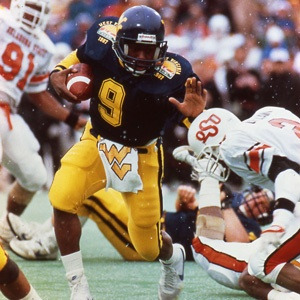
The Maulers would acquire QB/WR Raphel Cherry from Hawaii to backup Harris.
Seattle would pursue and land long time New Orleans backup David Woodley to be their starter. Seattle acquired Reggie Slack from Birmingham to backup Woodley.
Red Miller was not sold on Todd Dillon, so he acquired NFL veteran Marc Wilson from LA. Scott Mitchell would back Wilson up and eventually would replace him.
Dillon would be dealt to New Mexico along with backup Bob Gagliano. Memphis would acquire Whit Taylor from New York. The diminutive Taylor always had a live arm and quick feet, but the years of training under Mouse Davis would have dramatically improved the footwork of the former Vanderbilt star. Memphis would view him as a potential short term replacement starter when Moon’s career eventually ended and a good backup should Moon miss any games.
Miami would acquire disappointing former FSU star Peter Tom Willis. With only one year of significant starting time in college, the former Seminole had predictably struggled in Birmingham.
Miami thought of the second year man as a safe backup for Browning Nagle as Willis was not enough of a threat at the moment to unseat Nagle or shake Nagle’s confidence, but Willis had starting level talent. With good coaching and a couple years to develop without the pressure of starting, Willis had the potential of replacing Nagle in 2-3 years if the Lousiville thrower didn’t work out.
Sacramento would acquire San Antonio QB Kevin Sweeney to backup Dave Archer.
The Last Tumbler...
Finally, a week before the season, Vinny Testaverde was finally dealt. Testaverde had outplayed Browning Nagle in the pre-season much to the chagrin of Testaverde detractors on the roster and the front office in Miami.
To protect his trade value, it looked like they were going to have to start Testaverde.
Miami Head coach Howard Schenellenberger stepped in. He called around the league, eventually calling LA Head coach Don Coryell. Coryell was receptive of the deal conceptually but thought the price was insane.
They talked through the night and in the morning Schnellenberger dealt the Heisman winner to Los Angeles for a second round pick.
In his memoirs “The Franchise, Life under the Don”, Todd Marinovich pulled back the curtains.
“Training camp my rookie season was a real battle between Rodney (Peete) and I for the starting job. I hadn’t played especially well, but I felt like I had a good shot of passing him to take the job. Then about a week before the season Rodney gets called into Don’s office.”
“Anyway about 20 minutes after that I get called into the office. I am freaking out. Keep in mind I am a rookie. I know nothing about how this all works. I am thinking, ‘Is this how they name starters? Or did I disappoint Coach Coryell?’ I walked in moderately optimistic, but then I got kind of worried. I missed a lot of open receivers in camp...”

“So anyway, he tells me, “I am going to tell you some stuff that is just between us. The QB play has sucked this pre-season.”
“Rodney is not ready to be a starter yet. The Tathums spent the last two weeks trying to acquire Doug Williams from Oklahoma as Jim Stanley really wanted to acquire (New Orleans Saints free agent QB Bobby) Hebert. In a couple of weeks I was going to throw you out there even though you didn’t EARN the job.”
“Then Miami called me and offered me Vinny Testaverde. That guy can make all the throws and he has been a starter long enough to know what not to do.”
“So I took the deal. I just spoke to Rodney and let him know I traded him to Atlanta to back up Walter Lewis.”
“So my head is exploding at this point. This is like the last thing I expected. So he continues...”
“I want you to understand why I made this deal. You’ve been solidly professional, but you haven’t worked hard enough to be great. The only way you will be great...and I mean Dan Fouts great...is if you understand how hard it is to be great.”
“You won’t learn that if I just give you the starting job. You will assume you have done enough. With Rodney at the level he is at today, you just weren’t going to earn it.”
“I don’t want Vinny Testaverde to be my QB long term. He may surprise me, but I understand he is as dumb as a box of rocks. Now I run a QB friendly system so he will be pretty good, but I want a QB who gets what I tell him the first time.”
“That could be you, but he is every bit as talented as you are. If you are going to take the job, you’ve got to make better, faster decisions than he makes. Every job you’ve ever had you’ve earned with your talent. You’ve got to win this job with your head. The only way you’ll get this job is if you earn it.”
“It was like ‘Wow. This is huge.’ ”
“I am thinking he is done. He lets me get up and right as I am about to leave he throws this out... “
“Oh... And one more thing. We have one of the biggest payrolls in the league. The only way I got the Tathums to agree to this was to promise them that one of you would be gone by next season.”
“Kid...Don’t let it be you.”
“That was our meeting.”
“Man, Don knew how to get in my head. But I guess that is why he was a first ballot hall of fame coach. I spent every minute we weren’t on the field from that point on in the film room. I got a lot better that year.”
“Years later, I thought about this and realized he was right. I didn’t have the intensity and precision the greats had. He had to change my thinking to extract my talent. It was fucking brilliant!...But that was Don.”
“Plus it was a smart deal for Don. A second round pick was nothing for a QB as good as Vinny. If I played well, Don was going to get that back or more the next time the USFL expanded. If I didn’t, I would just be another failed first and LA wouldn’t blink an eye. Vinny was really good in that offense.”
Click here for previous post
0 notes
Text
89. The 1990 off-season --- Free Agents signed by the USFL
Plan B Signings
With Turner’s announcement of the USFL’s projected TV payouts for the coming season, a few USFL teams would dive in late to pull players from the NFL’s Plan B free agent pool, pulling several players for the last half of the 1990 season.
Birm - Crawford Ker G LA Express - Cin pro bowl G Max Montoya SA - Mike Baab C CLE, Dave Richards G SD, Mark Whalen DT Portland - Jay Novacek TE DAL, Mike Lansford K Rams, DC - Don Majkowski QB GB NY - Erik Howard DT NYG, Freeman McNeil RB NYJ Hawaii - Niko Noga LB DET
Charlie Pell would sign his former Florida Guard Crawford Ker.
Don Coryell would steal Pro Bowl guard Max Montoya from Cinncinati.
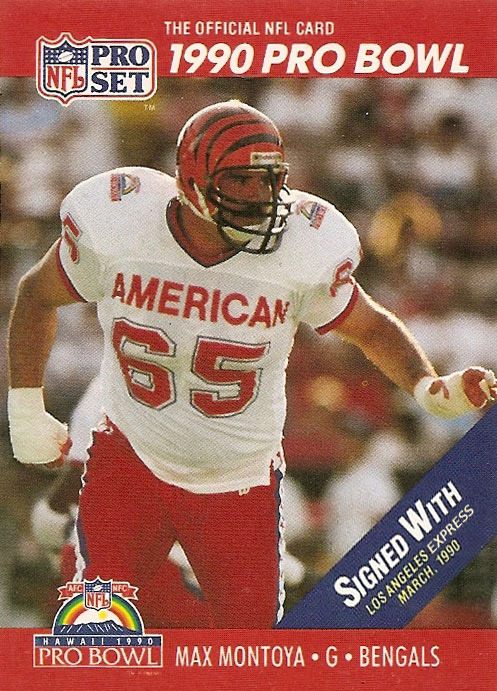
San Antonio’s Bill Polian would sign former UT star Center Mike Baab from Cleveland and former TCU and current San Diego starting Guard Dave Richards as well as former Dallas DT Mark Whalen to bolster Tom Landry’s lines.
Norv Turner would see Dallas’ 1990 plan B acquisition Jay Novacek as the perfect TE for his offense in Portland. Mike Lansford would be a sound acquisition as the teams’s kicker.
DC’s first player signed would be Green Bay’s starting QB Don Majkowski. Majkowski, stung by being put on the Plan B list by Green Bay, would realize that another 6 months to heal would actually be very good for his career long term.
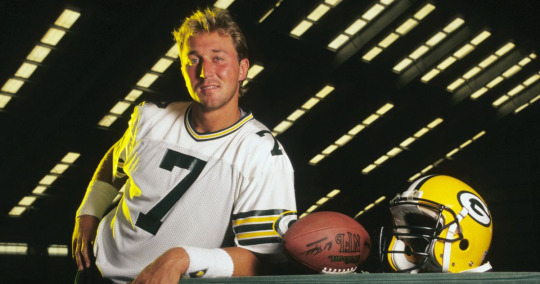
NY would sign NYG DT Erik Howard and NY Jets star RB Freeman McNeil. McNeil had gotten cross with Jets management and had seen his workload stripped away. This would leave him with fresh legs and the veteran would re-emerge running out of a run and shoot offense in the USFL.
Hawaii would sign Al Noga’s brother, Niko Noga, away from Detroit.
Other signings
San Antonio signs Steve Pelluer
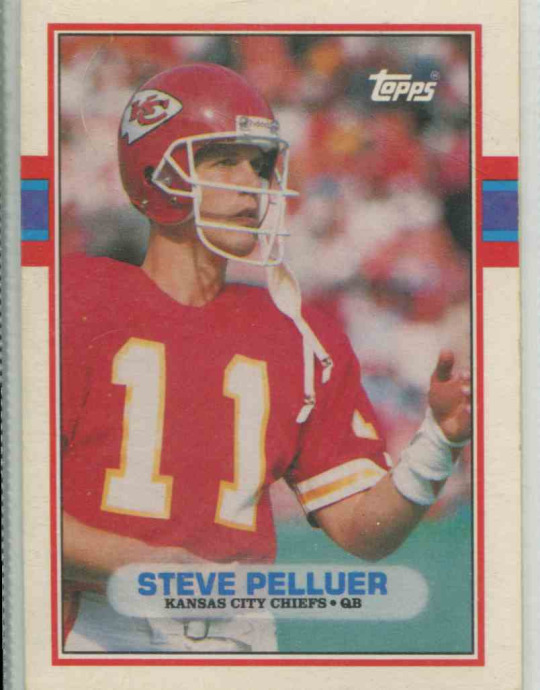
After a season of spot duty in 13 games after losing the starting job to Steve DeBerg, QB Steve Pelluer would walk out of training camp in Kansas City in on August 7th, 1991. He would return on the 19th, but the damage was done. Eight days later the team would release him. No NFL teams would pick him up.
With his career on fire, Pelluer and his agent would call around.
Tom Landry liked Pelluer’s approach to the game and loved his talent, but Landry was old school. The idea of a rebellious player didn’t sit well with Landry.
But… QB was a problem. Landry liked drafting raw QBs and letting them sit on the bench for 5 years so they could know the offense intimately and be used to the greater speed of the pro game before facing off against a pro pass rush.
Young Billy Joe Tolliver had a great arm but needed another 3 years of seasoning on the bench and a lot of refinement by Landry’s perspective.
Craig Penrose was like a poor man’s Danny White. He worked hard, didn’t give up the ball, and was respected for his work, but at this point in his career, Penrose didn’t have the arm to take advantage of the team’s speed.
Landry knew a QB change was needed to get to the next level. Landry really liked his former Dallas QB Gary Hogeboom as he was a fiery tough guy, but wasn’t sure if Hogeboom would be receptive. Landry thought maybe he could acquire him from Portland, but realized that would not sit well with White either. With too much potential for unrest there, Landry moved on.
Landry also thought he might be able to land a QB from Don Coryell’s LA Express. Marc Wilson was physically what you dreamed of in a QB. He was tall and threw a beautiful deep ball in practice and had some good coaching over the years, but had some pronounced flaws.
His teams didn’t seem to buy into Wilson and his career suggested Wilson wasn’t willing to do what was required to fix that. Additionally he seemed soft at times — intimidated by a strong rush — and wasn’t as accurate as you wanted. It was just a profile of a guy who didn’t work as hard as Landry would demand.
Rodney Peete seemed to have exhausted his starting days in LA. He was a fairly good leader and a very mobile QB, but his passing ability and in game play was only marginal.
Pelluer had run the team like Landry wanted in Dallas, was a fantastic talent with mobility, solid accuracy, and a good arm. He had a consistent throwing motion. Like White, Pelluer worked hard at his game. Landry had an appreciation for that.

Landry also believed Pelluer could get significantly better. He noted to Polian that Pelluer had gotten noticeably better every year in college, ultimately completing 67% of his passes as a senior.

Pelluer had been about a 55% passer in his three seasons as a part time starter in Dallas, but the offensive talent around him was in decline. Pelluer’s decision making got better each year. This fit Landry’s view on developing QBs. That confirmation of Landry’s worldview of QBs made Pelluer tough for Landry to pass on.
Landry thought Pelluer might be reaching his prime in terms of his understanding of the game and his adjustment to the speed of pro ball.
With the lesser closing speed in USFL secondaries, Landry figured Pelluer might have a Cliff Stoudt-like improvement just by changing leagues….but he wasn’t just counting on that. San Antonio was so loaded with weapons who could turn high percentage short dump off passes into big gains, that Landry thought Pelluer was LIKELY to have that kind of jump….If Pelluer’s head was still on right.
But was it?
San Antonio’s leadership decided to schedule a meeting with Pelleur and his agent to determine just that.
Two days later Pelluer and his agent would fly to San Antonio and meet with SA OC Danny White for 2 hour. White was charged with evaluating whether Pelluer was worth pursuing.
White would report positively to Coach Landry.
On August 30th, Pelluer would sign a 1 year deal “prove it” deal with San Antonio after a very short and pointed meeting with Coach Landry.
By the start of camp, a motivated Pelluer would have answered all questions and legitimately and significantly outperformed all of San Antonio’s other QBs to rise to the top of the San Antonio depth chart.
Click here to continue to the next post
Click here for previous post
0 notes
Text
88. The 1990 off-season --- Other rookies of note signed by the USFL
Other rookie signings of note
ARIZONA - Signed All-American FS Nathan LaDuke.
BALTIMORE - Signed All-American WR Jeff Graham of Ohio State.
BIRMINGHAM - Signed All-American DT David Rocker of Auburn and All-American K Phillip Doyle of Alabama.
BOSTON- Signed All-American ILB Michael Stonebreaker, ND.
CAROLINA - Signed 2 Clemson Tigers, G Stacy Long and DT Vance Hammond as well as CB Joe Johnson of NC State and All-American K Chris Gardocki of Clemson.
CHICAGO - signed 4 Illini, All-American NT Moe Gardner, DT Mel Agee, MLB Derrick Brownlow, and FB Howard Griffith.
DENVER - Signed 6 Colorado Buffaloes, T Ariel Solomon, All-American G Joe Garten, T Mark Vander Poel, CB Dave McCloughan, OLB Kanavis McGhee and All-American RB Eric Bienemy as well as Nebraska All-American DE Kenny Walker.
DC Signed All-American QB Shawn Moore of Virginia and T Erick Williams of C. State (OH)
HAWAII - Signed CB Brian Mitchell and T Neal Fort of BYU.
HOUSTON - Signed RB Chuck Weatherspoon and WR Manny Hazard of Houston, All-American C Mike Arthur of Texas A&M, and All-American K Roman Anderson of Houston.
JACKSONVILLE- Signed QB Craig Erickson of Miami, All-American WR Wesley Carroll, All-American WLB Maurice Crum of Miami, All-American LB Kirk Carruthers of FSU, and All-American DB Will White of Florida
LOS ANGELES- Signed All American G Mark Tucker and All American LB Scott Ross of USC.
MEMPHIS- Singed WR Anthony Morgan of Tennesse and OLB Tony Hill of Ten-Chatt.
MICHIGAN- All-American G Dean Dingman, All-American S/PR Tripp Welbourne of Michigan, TE Duane Young, OLB Carlos Jenkins, All-American G Eric Moten of Michigan State.
MIAMI- All-American LT Mike Sullivan of Miami
MILWAUKEE- Signed FB Bob Christian of Northwestern; DE Mike Flores and T Jerry Crafts of Louisville, All-American LBs Melvin Foster of Iowa and Mark Sander of Louisville, All-American CB Steve Jackson of Purdue, S Merton Hanks of Iowa and DE Don Davey of Wisconsin.
NEW ENGLAND- Signed All-American RB Mike Mayweather of Army, T Harry Boatswain of New Haven and G Tim Ryan of Northeastern, and All-American P Chris Shale of Bowling Green.
NEW MEXICO- Signed DE Micheal Sinclair of ENMU, DE Mitch Donahue of Wyoming, K Brad Daluiso of UCLA, WR Keenan McCardell of UNLV, RB Eric Pegram of North Texas, WR Kerry Cash and TE Keith Cash of Texas, TE Chris Smith of BYU, CB Sammy Walker of Texas Tech and All-American K Michael Pollak.
NEW ORLEANS- Signed WR Bobby Slaughter of LA Tech; TE Andrew Glover, RB Walter Dean, and WR Jake Reed of Grambling.
NEW JERSEY- Signed WR Rob Carpenter of Syracuse
OAKLAND- Signed DT Rhett Hall of Cal, All-American WR Ed McCaffrey of Stanford,and All-American RB Sheldon Canley of San Jose State.
OKLAHOMA- Signed CB Larry Brown CB of TCU, All-American RB Gerald Hudson of Oklahoma State.
ORLANDO- Signed CB Richard Fain of Florida.
PORTLAND- Signed RB Blaise Bryant and Gene Williams of Iowa State and QB Bill Musgrave of Oregon.
PITTSBURGH - Signed 4 Pitt Panthers, RB Curvin Richards, DT Mark Gunn, All-American P Brian Greenfeild, and S Louis Riddick.
SEATTLE - Signed G Jeff Pahukoa, G Dean Kirkland, S Charles Mincy K Brad Daluiso, and All-American RB Greg Lewis of Washington .
TAMPA BAY- Signed CB Robert Bailey of Miami and All-American WR Lawrence Dawsey of FSU.
Click here to continue to the next post
Click here for previous post
0 notes
Text
87. The 1990 off-season --- draft day fallout with the NFL
While 4 of the top 5 prospects on the NFL’s draft boards would wait to sign with the NFL and sign immensely lucrative deals, the USFL teams would show great insight in attacking the NFL’s “fat contract” plan by leveraging nearby locations and clever pick placement to gut most of the NFL’s first round prospect pool, with only 8 of the league’s top 20 prospects waiting for the NFL draft. In fact, of the NFL’s 28 top ranked prospects only those 8 waited for the draft. Unlike in other years, the USFL had also gutted most of the rest of the draft as it sought to staff it’s four new teams.
This created issues for the NFL. While the 8 players who waited did get premium offers, most NFL teams after that point resisted the call from league leadership to pay second round prospect as mid first round players at premium rates.
“Why should I pay a second round grade player a premium on what a middle of the first round guys should get? Why should I pay a guy I had a third round grade on ‘end of first round’ money at all? I have a roster to fill you know!” Owners would ask Commissioner Paul Tagliabue. He had no good answer. In theory, if the league paid the premiums, the next class would be very unwilling to sign with the USFL teams, but pushing the concept of overpaying a net weak draft class just wasn’t going to fly with NFL owners. The League’s policy had been thwarted by Turner’s increasing money stream.
With the premiums suddenly gone, several pro-NFL agents felt lied to. The NFL had a crises brewing for the 1992 draft. Something had to give.
While old school NFL owners were deadset that the draft should not move based on old man thinking (”It’s a privilege to play in the NFL! Keep the draft where it is. We will get the best players.”) new blood owners like Jerry Jones saw the problems.
While Dallas had come out of the previous 3 years like a comparative rose landing 4 good starters with QB Troy Aikman, WR Anthony Miller, DT Cortez Kennedy, and RB Harold Green out of the first rounds of drafts where many teams had only landed 1 first round pick over that period, even Jones felt the impact in 1991.
They had entered the draft with a fair amount of draft picks with 1(1), 1(20), 2(37),3(62), in the early rounds. They had anticipated trading down and loading up raw talents in this deep draft, but the USFL adding 4 teams and drafting regionally both via the normal draft and in their territorial assignments had put a fork in that plan.
All the small school talents Dallas had been tracking were sucked into the USFL via their Territorial draft system and expansion efforts. Erick Williams was a stating right tackle for the DC Federals. Tony Hill was an OLB for Memphis. Kevin Harris was a starting DE for San Antonio. Leon Lett was a starting DE for the Milwaukee Visogoths.
Dallas hadn’t done much better with their Division IA prospects. While they did land Russell Maryland, their other likely first round target Alvin Harper was lost to the USFL. As were their second round target Dixon Edwards, 4th round target RB Curvin Richards (Pitt), QB Bill Musgrave (Port), 5th round target MLB Darrick Brownlow (Chic)….
Dallas was forced to trade some high picks into the 1993 draft and try again next season.
But the old guard of NFL owners’ position with the draft threatened to skunk that draft too.
Additionally, because NFL teams didn’t know which seasons the draft would be picked over by the NFL and which wouldn’t, Dallas found that teams were far less willing to trade future picks.
Teams didn’t want to trade a first round pick in an undisturbed draft for a first round pick in a gutted one where they would land a second round talent.
Dallas had built their momentum to become a better team off trades and the existence of the USFL was cutting into that.
Jones wanted the NFL draft moved to the first week of January to coincide with the USFL draft. “The added value of slotting the superbowl winner in as the last pick in the draft does not add a significant value and certainly not enough to offset giving the USFL a several month head start in signing the next NFL stars.”
When there was no support for that, Jones argued to have the draft the weekend after the superbowl, the first week of February. That would give the rookies a clear view of their NFL team with weeks to go in the USFL’s pre-season. NFL teams who wanted to outbid a USFL team to retain their picks would likely be able to do so.
Jones was eventually only able to convince the old guard NFL owners to agree to “compromise” and move the draft into mid-March, about a month into the USFL regular season. As this was a good four games into the USFL’s short season, the NFL teams felt it put more pressure on the USFL teams.
Jones argued that it was a partial measure only. “This is only going to appeal to players who have a clear NFL bias, If this was in place this year we might have saved 3-5 more first round picks, but that is likely it!”
He argued that currently the NFL position seems unreasonable to the college players. Those players would rather have money today than tomorrow and consider the NFL owners to be needlessly unreasonable by having their draft so late.
He argued this third plan was in his opinion the weakest, but could turn the table perception-wise at least to a small degree, creating behavior by the USFL owners that at least SOME prospects might consider unreasonable. Jones thought this could lead the USFL owners to start pushing deadlines down on the players.
“Sign by training camp or don’t sign at all!”
This arguement resonated with the old school owners as being what many of the USFL owners’ positions would likely become.
Jones thought if a player called that bluff and waited until a month in to the USFL season “to see” what the NFL teams would offer, the NFL would have an excellent chance of signing those players with their larger money deals, as for those players who chose to wait, the appeal of playing in the USFL would largely evaporate ---- but that it would not be nearly as effective as the first two options with the rest of the players who did not have a firm NFL bias.
Regardless of his position, the other owners only agreed to implement the last plan, something they labelled “The Jones Plan”. Jones would request and be granted permission to try to formulate better alternatives to be considered by the league owners in the fall.
They would keep the decision in-house then announce the change the following January, right before the next USFL draft.
The end of the Hula Bowl
With the success of the Hawaiians, The NFL owners decided to take it out on Hawaii fans and move the Pro Bowl to other locations.
The USFL, realizing the PR backlash they could feel in Hawaii if the fans blamed them for the loss of the Pro Bowl, agreed to Hawaiians’ owner Christopher Hemmetter’s demands to implement their own all-star game in Hawaii immediately, if TV would make it viable.
Ted Turner gave his thumbs up on the numbers and The USFL’s Elite Football Players Matchup (”The Elite Matchup”) was born.
This would recast the public perception of the NFL’s decision to be what it was --- a dick move designed to punish a fan base.
This would put a tremendous PR backlash on the NFL.
Click here to continue to the next post
Click here for previous post
0 notes
Text
86. The 1990 off-season --- The 1991 USFL draft
The 1991 USFL draft
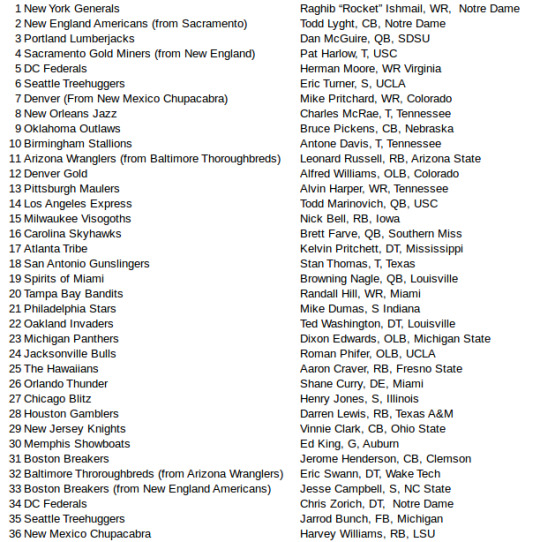
The 1991 Draft would be disrespected by fans but not by evaluators of NFL talent. The year’s draft would be considered largely devoid of true “blue chip” talents or ready to go QBs by the fans and the media, but would be one of the deepest drafts in several years with several raw talents with great upside. “This is the kind of draft where a team or two might have one of those once a decade drafts where they hit on a player in almost every round.” an NFL scout would tell a reporter after the bowl games.
The USFL’s latest expansion and the influx of money from the league’s TV partners would kill that NFL dream.
Notre Dame Heisman Trophy Winning WR/KR Raghib “Rocket” Ismail was considered the #1 talent in the draft by a large margin. The Dallas Cowboys owned the NFL’s number 1 pick after trading up with New England from #12. The Cowboys had already picked up WR Anthony Miller, QB Troy Aikman, DT Cortez Kennedy, and RB Harold Green in the prior three drafts. While adding a deadly complimentary receiver like Ismail to partner with Miller and Aikman made sense on paper, there was a general feeling that Jimmy Johnson was out on principle on spending the #1 overall pick on a #2 WR.
Add the fact that the NFL was spending 2-3 times what they felt they should be on first rounders and signing Ismael seemed to rub Johnson the wrong way. There was no question he saw enough value to take Ismail #1 overall, but to pay him at a premium? It was unlikely.
This was a problem for Dallas as Ismael was not going to be without suitors. The CFL’s Toronto Argonauts had been sold to a group that included actor John Candy. The Argos were going to make a serious run at Ismail if only for the PR value.
There was no way Dallas was going to be able to sign Ismail on the cheap. This spurred New Jersey Generals owner Stephen Ross into action.
The New York Generals surprised no one by signing Rocket Ismail to a very large contract to be the first pick in the draft. The most surprising thing about the deal would be that Ismail would end up making less than most expected when the terms were finally announced. It appeared that the early nature of the spring draft prevented the Candy group from putting together the sizable offer most expected and frankly, Ismail was eager to play his pro career in a run and shoot offense.
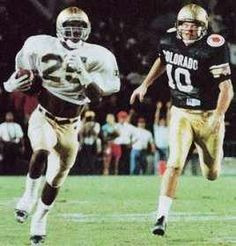
Sacramento had thought to pay handsomely to land Todd Lyght — considered one of the two best CBs in the draft and certainly the highest profile one. Lyght was impressed by Gold Miner defensive coordinator Charlie Sumner but was leaning towards waiting for the NFL draft. Sacramento spoke to Russell Maryland next , but quickly became convinced he cut a deal with Dallas on the cheap to go #1 overall in the NFL draft and was unlikely to look at Sacramento, so the team opened up talks to trade down. New England’s Vince McMahon saw a player he could sell in New England in the former Notre Dame star CB and traded up. McMahon was able to convince Lyght that his team offered Lyght the chance to make additional revenue as a spokesman in New York City AND New England. Lyght was taken with the proposal and quickly signed.
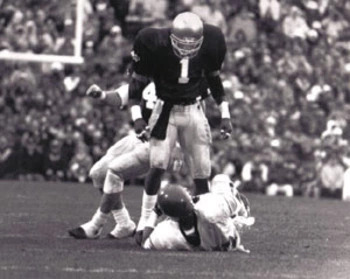
It was thought that Portland would pay Pat Harlow handsomely to protect Gary Hogeboom’s blindside, but the Lumberjacks surprised everyone when Norv Turner drafted San Diego State’s Dan McGuire, the Brother of Oakland Athletics star Mark McGuire. While McGuire was the #1 rated QB prospect in the draft, he had his flaws. While he was big with a strong arm and a winning personality, his decision making and release weren’t as quick as one would hope and he had started fewer college games than one would have liked. He was considered a raw middle of the first round prospect. Turner was worried that Hogeboom was too reckless and might quickly become injury prone in his 30′s, even with Harlow there. The thought was that at his size, McGuire could take some hits. Turner knew Paul Allen loved the thought of marketing the 6′8″ Dan McGuire and respected Turner as a QB whisperer. Turner thought he could mask McGuire’s deficiencies in his QB friendly system that mostly required a QB who could throw a consistent Slant route and bring him around slowly in a year or two. This plan fell apart when Hogeboom’s agent immediately request a trade.
Sacramento realized they had little to offer a player in terms of glitz, so they thought they would target a player they could impress with a red carpet rollout….an offensive lineman. They drafted Pat Harlow out of USC. Harlow was a Californian and the idea of making good money and not leaving the state appealed to him.
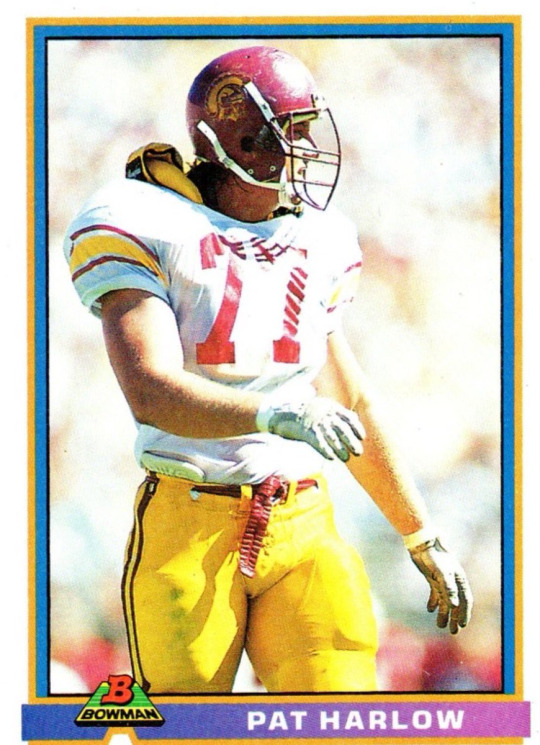
The DC Federals went after a guy they considered the best WR prospect in several years….Herman Moore. Moore was a tall breakaway threat with off the chart hands. Moore would be very receptive to staying in his home region and playing for a coach with a great offensive mind for whom he had a ton of respect.
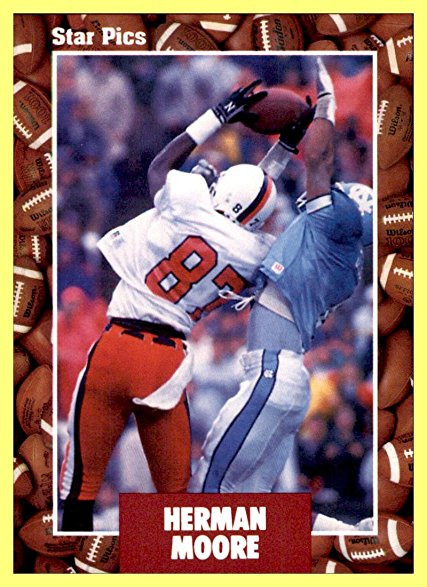
Seattle’s ownership would have a coin flip between safeties Eric Turner and Stanley Richard as a high caliber defensive player they thought they could land. Richard would seem taken with waiting for the NFL draft, so the team would pick Turner. After drafting him they would discover that Turner was leaning towards staying in for the NFL draft as so many players seemed to be signing with the USFL. This was only cemented when Cleveland fell in love with Turner when he climbed over a locked fence to participate in their workout. Seattle would find themselves unable to trade his rights.
New Mexico’s owners, the Maloof family, had their eyes set on Dan McGuire to be their featured star, but when Portland took him they thought about trading down. Their coach, Craig Morton, had been ok with the McGuire plan, but he preferred to sign a veteran QB anyway as they make fewer mistakes and he saw McGuire as a bit of a project. “We don’t have to be the most talented team in our first year, we just have to spend our picks wisely on contributors we can sign in the first three years. We can get a good RB or WR to sell to the fans with our second first round pick.” He argued. “We don’t have to keep the first pick.” Morton wisely advised that it would be tough selling Albuquerque to rookies, so it would be better to build a respectable team of hard working younger vets first. “We can always trade for Testaverde, Hogeboom, or Craig Penrose,” He argued. He had worked up a contingency deal with his former team, Denver, in case McGuire was not there. New Mexico traded away the #7 pick for Denver’s first pick in 1992 as well as several vets. Denver would pick popular Colorado game breaking WR Mike Pritchard. Pritchard was raw as a receiver, but his talent was indisputable. He had averaged a mind boggling 26.4 yards per catch for his college career. New Mexico loved him and their fans were disappointed with the trade, but Pritchard’s agent had made it clear that Pritchard would only play for Houston, Memphis, Denver, or New Jersey in the USFL….other than that, he was content to wait for the NFL draft.
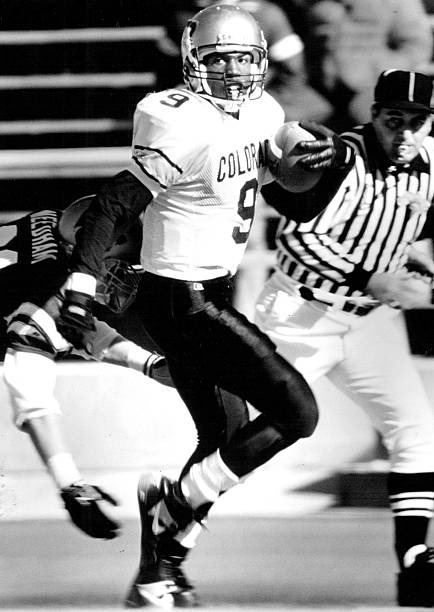
Archie Manning quickly selected Tennessee Tackle Charles McRae for his New Orleans team. McRae would fall victim to Manning’s charisma and sign quickly. Manning considered McRae a natural blindside protector for Tommy Hodson, who had taken a beating his rookie season. Manning liked Hodson and thought the kid showed a little potential…Manning didn’t want Hodson to have a career like Manning had with no personnel support on offense. This was the only reason Manning passed on his favorite prospect, a local player by the name of Brett Farve. Farve had a lot of moxie and a huge arm, but had been involved in an auto accident that he was still recovering from and was very undisciplined on and off the field. Ultimately Manning decided the safer option was to give Hodson the tools to succeed.
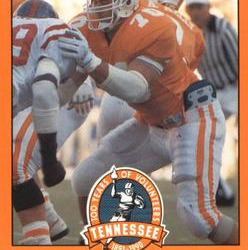
Although Oklahoma liked Nebraska LB Mike Croel, there was a general consensus that Croel was waiting for the NFL draft and they needed a replacement for the retired Peter Raeford at CB, so they drafted his teammate CB Bruce Pickens. Pickens would listen to the Outlaws, but Croel rightly convinced Pickens that if they waited they would both be top 5 picks in the NFL draft.
Birmingham would quickly chose Tackle Antoine Davis. Charlie Pell was a sound coach who realized nothing worked with a questionable offensive line. Davis projected as a right tackle who could probably also play left tackle at a high level in the USFL. The problem was Davis’s agent. Davis’s agent would wisely tell the player to wait for the NFL draft as Davis was likely to be the #1 OL in that draft. Davis would listen to the advise for a couple of weeks before the Birmingham’s minority ownership group would exercise their Auburn recruiting networks and start making offers to Davis’s extended family and friends, improving the perception of the USFL in the Davis household. Davis would warm to the USFL and be signed by the end of camp.
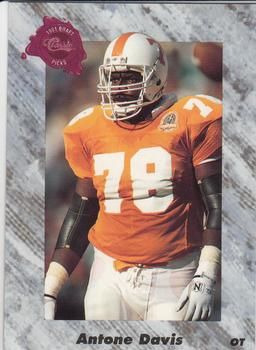
Ted Marchibroda would be disappointed to see the 3 elite offensive tackles off the board. He would toy with drafting Florida OLB Huey Richardson, but would instead pull the trigger on a trade with the Arizona Wranglers for their first and second round picks. Arizona was in love with the idea of signing Arizona State’s star RB Leonard Russell. They thought the powerful Russell would fix a long time problem —an inconsistent running game — as well as give Phoenix fans a second new reason to come to Wrangler games (in addition to their championship win). Russell would quickly sign at a reasonable price.

On the clock again, Denver would draft and sign Colorado OLB Alfred Williams. Williams would sign a reasonable contract to play for Denver when the Gold assured him they planned to “Go all in on Buffaloes” in the draft. (They would also take and sign RB Eric Bienemy and OLB Kanavais McGhee in the second round.)

Pittsburgh would draft Tennessee deep threat Alvin Harper to plug in opposite Greg Anderson. Impressed with head coach Al Saunders and the prospects of the team, Harper would take a reasonable deal given general uncertainty about his placement in the NFL draft.
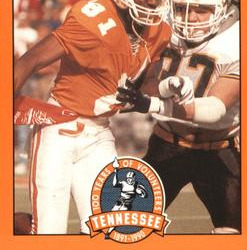
Don Coryell would surprise everyone with his selection of USC QB Todd Marinovich. Marinovich had legit elite level talent, a great feel for the game,a big arm, good feet and mechanics, but he was a scratch on most team’s draft boards due to cocaine & Marijauna use, insubordination, and weird family dynamics. He was considered another hit or miss second round prospect… at best. Coryell hated the insubordination and cocaine and told Marinovich from Day 1 that would not be tolerated, but the two men really clicked. Marinovich had both the talent and a well developed understanding of the game that Coryell wanted and Coryell gave Marinovich an alternative NFL success model to his dad. It came out of nowhere, but Marinovich fell in love with football again. Marinovich would later write “Don was amazing. He really turned my life around. He told me, ‘You can be the jerk you have been for the last year and the Raiders will likely draft you in the first round because of your Dad, or you can be the MAN I see and know and I’ll draft you because of YOU.’ Dude… It sent a shiver down my spine. It still does every time I tell the story. There is a reason he was a first ballot hall of fame coach. I quit partying and all the hard drugs and toed his line. Except for occasional pot in the offseason,... I was done with it. It was weird, I never got it before, but from that point forward I enjoyed football on a whole new level.” Marinovich would sign a multi-year deal at a deep discount --- about what he would have made if the Raiders had picked him at the end of the NFL’s first round.

The surprises continued in the draft as Milwaukee coach Hayden Fry picked and signed his former collegiate RB Nick Bell next, despite having Anthony Thompson on the roster. Bell was considered a second or third round caliber back, but his speed and athleticism for his size was off the charts. Fry would explain in the press conference, “Don’t read anything into this. Nick is a special talent who is getting better as a runner each season, but Anthony is one of the best RBs in the league. I am making this pick because Anthony is not a big guy and he ran for over 1600 yard last season. The USFL plays an 14 game regular season plus several playoff games. If I do that to Anthony every year, he’ll be done in this league in 5 years. If I can offset some of the load to Nick, both might play 8-10 years much like Buford Jordan and Marcus Dupree did in New Orleans. I’ll have done better by both of them.”

Carolina had a QB problem as a chronic shoulder injury forced longtime starter Mike Hohenesee into retirement. Hohenessee would become the team’s new QB coach. With a gaping hole at QB the assumption was that the team would sign a veteran or trade for Vinny Tesreverde. They did neither, instead opting to draft Brett Farve a round ahead of schedule. Both Head Coach Jonnie Walton and Hohenessee saw a special focus in the raw Southern Miss QB. Farve would realize that his car accident injuries were working against him and he would never go higher in the NFL draft, so he quickly took the money.

Atlanta would draft Mississippi DL Kelvin Pritchett next. Pritchett would wait for the NFL draft.
San Antonio would quickly draft and sign UT OT Stan White who would be taken with the idea of playing for Tom Landry.
With almost all of the top rated QBs off the board, the Spirits of Miami would draft Louisville QB Browning Nagle a bit earlier than most media thought appropriate. Coach Howard Schnellenberger instantly clicked with Nagle who played the position the way Schellenberger envisioned. Miami was worried when Carolina didn’t take Tesreverde that the Skyhawks might take Nagle, the only other “ready to play” QB prospect in the draft, even though he was graded a second round prospect. When Carolina didn’t Miami quickly scooped him up. Nagle quickly signed a reasonable long term deal.

New Tampa Bay coach Rich McGeorge would finally satisfy QB Chuck Long’s long instance that the team was leaving points on the field by not having more speed at receiver by drafting Miami WR Randall Hill. Hill would consider waiting for NFL money for a day or two, but the idea of staying in Florida and playing with a guy who appeared to be a future Hall of Fame QB was too enticing. He signed a reasonable deal.

Philadelphia would draft and Indiana safety Mike Dumas at a slight premium to fill a longtime hole in their secondary.

The Allens would want to draft Mike Croel of Nebraska as he was the last unspoken for lottery talent on the board but the move would be rejected by management as too expensive and possibly fruitless, so the Allens would instead draft Louisville DT Ted Washington. Washington was as big as the nose tackles of the day but had the ability to generate a pass rush. Washington would want 3 times what a pick in the 20′s had gotten the year before, arguing that given that most of the 1st round physical talents had signed with USFL teams, he was likely going to go in the top 10 and be paid a premium by the NFL. The Allens would make the same case to Oakland’s owners and they would grudgingly agree. “Even when George Allen is on a budget, he overspends....” Tad Taube would groan.

Michigan would draft Percy Snow’s Michigan State sidekick —hard hitting and mobile OLB Dixon Edwards. Expected to be a second round pick, he would sign an inexpensive deal.
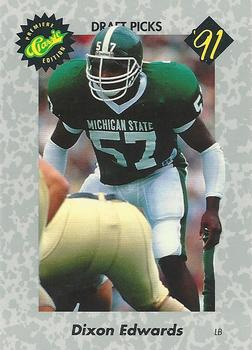
Jacksonville wanted Ted Washington but would settle for UCLA OLB Roman Pfifer.

Hawaii would finally land a true feature back in Fresno State’s Aaron Craver. Craver, at 215 lbs., had good size and very good speed. Projected as a second round pick, Craver would sign a fairly inexpensive deal.

Orlando would draft and sign second round grade prospect DE Shane Curry of Miami at 26. He would sign a fairly inexpensive deal.
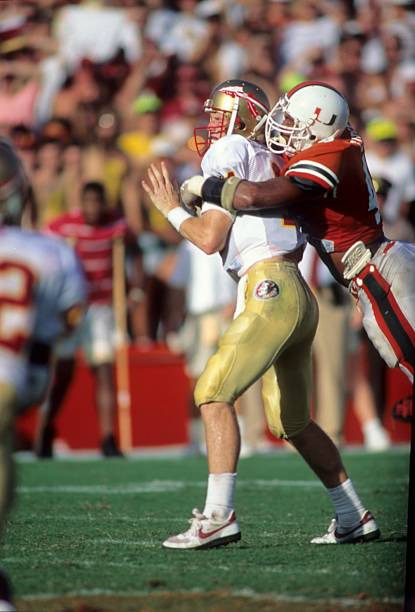
The Chicago Blitz would draft and sign Illinois S Henry Jones.

Houston would consider Michigan FB Jerrod Bunch, but would take Texas A&M’s legendary RB Darren Lewis. Lewis would initially decide to wait for the NFL draft, pissing off Houston, but then he tested positive for cocaine at the NFL combine. He would end up signing a one year “prove it” deal with the Gamblers for the league minimum.

The NJ Knights would sign CB Vince Clark of Ohio State at a major premium to become the team’s #1 CB.

Memphis would take Ed King at #30. King liked the Showboats but the money wasn’t rich enough and the NFL draft appeared gutted, so he waited. He would go early in the NFL draft.
Boston would draft Jerome Henderson to help their secondary at 31.
Baltimore would shock the world by taking semi-pro prospect Eric Swann at 32. Marchibroda had fallen in love with the kid’s game. Swann had elite size, strength, and talent and didn’t take plays off. With no college experience, the pick would be widely questioned by the media. He would quickly sign with Baltimore.
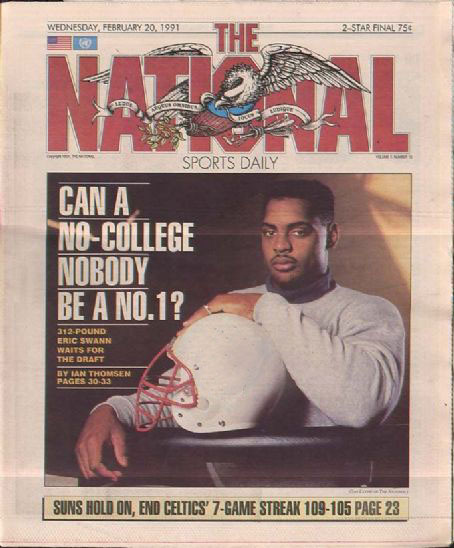
Boston would pick safety Jesse Campbell at 33 with the pick they acquired for QB Mike Buck. Boston had not accounted for the success the USFL teams would have signing draft picks. Their plan of picking up secondary help at reasonable prices would not work out as the players’ NFL leverage increased. Boston would whiff signing both players.
The Federals would pick up Notre Dame bare bellied NT Chris Zorich at 34. Zorich was a very active DT who played with fire and promotionally, was a great name in football. The Federals would pay a slight premium to land the second round grade prospect.
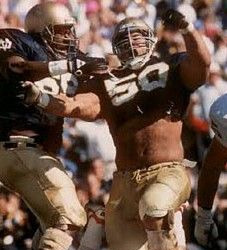
Seattle’s original plan had been to pick a defensive player from the lottery who they felt they could sign and then with their second pick try to land any upper level defensive player who other teams didn’t think they could sign without causing salary issues on their team. Turner didn’t work out for them, but a faction in their group felt they probably could pay either OLB Huey Richardson or MLB Mike Croel what they wanted to pay Turner and survive this first draft with a name player to sell to fans. The trouble is the majority of their coalition was more conservative and felt both players were solid in waiting for the NFL draft. That conservative faction favored drafting a player they knew they could sign, so they drafted Jarrod Bunch HB/FB out of Michigan. Bunch had been converted from a tailback to a FB in college. Seattle would sell Bunch that he would be the feature back in Seattle’s run focused game plan. Bunch, tired of being viewed as only a FB, would quickly sign for a slight premium.

New Mexico would make the final pick of the first round landing LSU’s RB Harvey Williams, who some scouts would call a poor man’s Eric Dickerson.
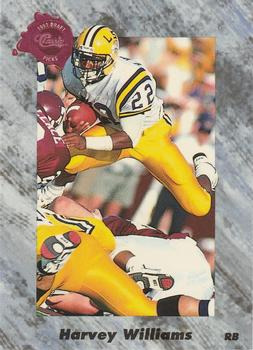
The success of the USFL in signing players ahead of the NFL draft, despite the NFL’s offers of premium contracts, would have ramifications for both leagues.
Click here to continue to the next post
Click here for previous post
0 notes
Text
85. The 1990 off-season --- Coaching and front office changes
Coaching Changes
New Orleans would look to move away from the Veer with new talent Tommy Hodson entrenched at QB. Their leadership wanted a coach who could develop Hodson in a pro set.
They talked to former Carolina head coach Roman Gabriel, but he lacked the local credibility they were seeking. Eventually an offhand comment lead them to a surprising, but inspired choice — former Saints’ QB Archie Manning.
Manning would take the job on one condition — he alone would have final say on the team’s first round picks.

(Manning would hire two key figures from his past to be his coordinators. Former Saint OC Ed Hughes, the OC during Manning’s best years, would be the Offensive Coordinator and Manning’s former Saints Head Coach during the same era, Dick Nolan, would be the Defensive Coordinator. Both would come due to their respect for Archie Manning.)
Manning would want to totally rework the Breakers’ passing game. He would see it as the team’s veteran receivers had gotten so comfortable in a run-first offense that they no longer ran tight routes. They could still make plays, but there was no consistency to their routes. Privately he would tell his staffers in New Orleans “You can’t teach old dogs new tricks.”. He would say that the lack of discipline to their routes would end up generating a lot of future hits on Hodson.
He wasn’t going to have that. Manning had lived through being a QB with no player support from management and wasn’t going to let that happen to Hodson. Manning told his staff that he was hugely impressed with the emerging talents at Grambling and some of the other area colleges and wanted to rebuild the receiving corps with rookies.
Carolina’s ownership would hate that they had to fire Head Coach Roman Gabriel after the team responded well down the stretch and the offense had really come together, so they would offer the job to Offensive Coordinator Jonnie Walton for continuity’s sake. Walton would initially balk at the offer until Gabriel himself encouraged Walton to take the job.
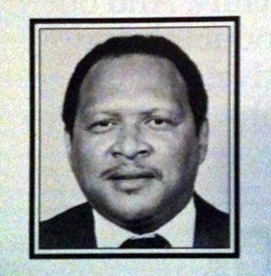
Denver’s new majority owners, Alan Harmon and Bill Daniels, would reach the conclusion that the run and shoot may keep you in games, but unless you had an elite QB, it wouldn’t win you games. With that in mind, they would seek a return to what worked well with the fans early on — smashmouth football played by a lot of local fan favorites, mostly former Bronchos.
As they admired the work of original Gold owner Ron Blanding in building a team the fans loved, they would try to re-create it. They would re-hire popular former Bronchos and Gold coach Red Miller.

They would instruct their GM to look for a team to acquire a few of the Gold WRs in order to clear space to sign promising players who failed to make the Bronchos’ roster the last few years. (The goal was to change out the bottom half of the roster and make it more fan friendly.)
They also saw the Colorado Buffaloes National Championship team and recognized an emerging opportunity to bring in a lot of talented locally popular players if they could gather enough picks in the upcoming draft.
Denver and New Mexico would have advanced talks about several players.
The Gold found a willing partners in their wide receiver transaction in both to the New York DMA franchises.
New Jersey’s Mouse Davis would happily turn over second round picks in this years draft and the next for Denver’s star WR Leonard Harris.
New York’s Stephen Ross had reached the conclusion that without Hershel Walker, he would need to really feature QB Steve Young to stay in the public’s eye. What better platform for the accurate, decisive, and mobile Young than the run and shoot? He was certainly smart enough to handle it. Additionally with the league’s first pick, the draft would dictate they look to sign Heisman Winner Rocket Ismail who would be perfect in that offense.

New York would trade their second round pick this year and next year to Denver for veteran run and shoot WRs Marc Lewis and Vincent White.
With no FB in the offense, all star FB Maurice Carthon would be granted his release to sign with the New York Giants.
Ross would make a somewhat unpopular choice in hiring former Denver Head Coach June Jones to replace Walt Michaels, but given his plan, it was quite defensible.

To keep Chuck Long happy, Tampa Bay would promote former Green Bay TE and longtime Offensive Coordinator Rich McGeorge to be their new head coach.

Click here to continue to the next post
Click here for previous post
0 notes
Text
84. The 1990 off-season --- Expansion: Team 32: NY/NE area
Turner’s shock!
The league had a few offers for the last team — a team in the NY/NE area.
A potential ownership group arose in Buffalo, but the league leadership was cool to the idea as they thought a USFL team in Buffalo would drive out the NFL team — a situation that would cause general ill will towards the league.
The Syracuse group lacked sufficient finances to pass the league’s valuation criteria.
The Rochester group had the finances, but no sufficient stadium. They were also unwilling to work with the other groups and as the USFL had a “good faith” clause in dealing with applicants, that was that.
The Bronx group didn’t seem credible and no one really was feeling Hadhazy’s suggestions for rehabbing Downing Stadium in New York City for a USFL team. (Hadhazy would flex his muscles and get the league to contribute $4 Million —matched by the city for a total of $8M — to fix the lighting in the stadium, update the scoreboard, and fix the broken and worn benches, He would do this to support his effort to get the league to play two preseason games there. Both games were sellouts — although the fans complained about the facilities.)
Then a surprise candidate came in with sufficient funds, a sufficient stadium, and a solid plan. The candidate was likely to agitate Turner so, the league leadership simply presented the proposal to Turner for his opinion. Surprisingly Turner gave his approval.
Vince McMahon, owner of the rival World Wrestling Federation, the main competition for Turner’s World Class Wresting was approved to own the league’s 32nd team.

The New England Americans would open play in Yale’s 70,000 seat Yale Bowl.
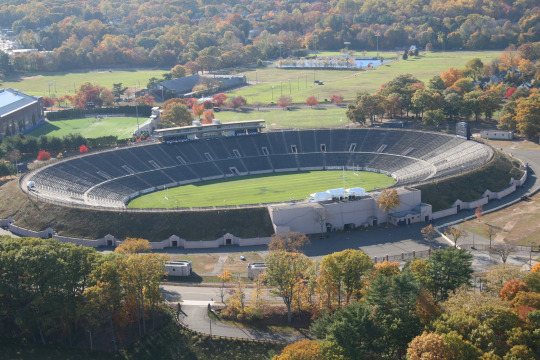
McMahon would state rather bluntly that while he was thrilled with the stadium, both sides had agreed that it would be a temporary home for 3 years until, ideally, a sufficient stadium (greater than 50,000) was built in downtown Hartford to host his team (and potentially the University of Connecticut Huskies… if they decided to move up to Division I-A in football, as their Athletic Director was allegedly seeking to do).
Should that not happen, the team would either try to extend the deal with Yale or, more likely, move either to the Bronx or potentially an improved Downing Stadium.
They would be coached by popular recently fired Patriots coach, Raymond Berry.
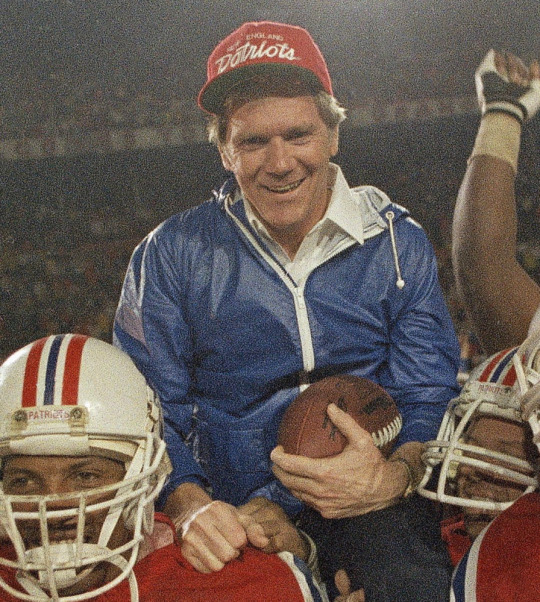
Click here to continue to the next post
Click here for previous post
0 notes
Text
83. The 1990 off-season --- Expansion: Team 31: Pacific Northwest
Portland gets a rival
Upon the decision to expand, Portland owner Paul Allen would take it upon himself to get a rival team in place in Seattle. Allen knew there were painfully few investors in the Northwest who would be willing to put up the money to buy a USFL team, even though the league leadership had encouraged the members to keep the buy in price low for another year.
The USFL had had contact with an investor group years earlier which had tried repeatedly to establish a team and failed.
Allen guessed they didn’t have the financial backing for league approval in this day and age. Still he met with them and was impressed with their enthusiasm for the league.
While he could have made a token investment to help them to their goal, he felt that might lead to future conflicts among owners and create questions of fairness (something that constantly dogs very rich owners in leagues).
So Allen decided he would find a wealthy target to convince to become the majority owner of the Seattle investment group. After about a day, he set his eye on his friend and fellow NBA owner Barry Ackerly of the Seattle Supersonics.

Allen made an appointment to see Ackerly and convinced him it made a lot of sense to join this new league that Ted Turner was effectively fronting with these growing payouts. It was a comparitively cheap buy in and had good long term prospects.
Ackerly who owned the Ackerly Group, a multimedia company with TV and radio stations all over the country, was, at this point, very familiar with Ted Turner.
Ackerly could see the potential value for his business in an opportunity to regularly interact with Turner, but had no interest in football.
“Ah! That’s where I have you covered,” Allen would recount years later, “ I know of a minority ownership group that wants to run the club, but they are just a few bucks short to buy in and short of the valuation to get approved.”
Allen had figured out a series of deals to protect Ackerly’s investment.
Ackerly would pay for 40% of the buy in and receive 51% of the team on the condition that the minority ownership group would run it for the first 10 years. If the team was over .500 in that time period, something that suggested a solid financial footing, the minority owners would be able to purchase 11% from the majority owner for $1 and retain gameday control. If after 4 years, the team had not won at least 7 games in one season or if they were below .420 after 10 seasons, the majority owner could chose to put in place his own staff.
Given the TV money coming in, both parties were willing to accept the deal. The team would be announced in a press conference in the first week in April.
Ackerly named the franchise “The Tree Huggers” in a tip of the hat to the liberal bent of his fans and as a jab at Allen (Owner of the Portland Lumberjacks) for getting him into the USFL. He would announce that he and Allen had agreed to a “loser buys dinner” deal for their matchups (an oddly effective recurring promotional strategy that humanized both owners to their fans).
Seattle’s icon would be a heart behind a tree.
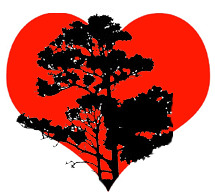
Ackerly’s minority ownership group would make quite a headline when they attempted to hire Chuck Knox away from their NFL rivals. Ultimately Knox would publicly state he was flattered with the offer but wanted to stay with his NFL team.
The minority owners would decide they needed a coach who would play rookies and steal a win or two in the first 2 years even if he wasn’t their long term coach. They agreed that the best bet was to try to build a good defense and a strong running game and try to control both the clock and turnovers….basically the Chuck Knox model.
They tried hard to lure Chuck Fairbanks out of retirement, but couldn’t do it.
Their third candidate contact bore fruit as they hired former New Orleans Jazz coach Bobby Collins in July. They thought Collins checked all of their boxes as a short term hire. He could build a program, win games here and there where he probably shouldn’t based on his unique scheme, and then when Knox’s relationship with the Seahawks finally fully collapsed, it would be easy to transition to the “Ground Chuck” offense.
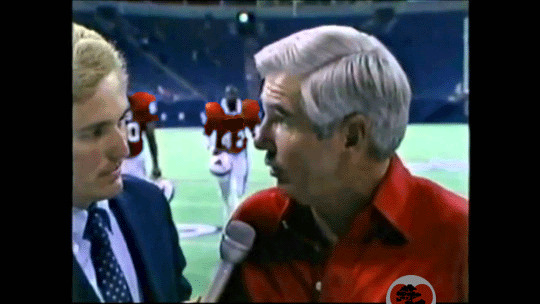
Click here to continue to the next post
Click here for previous post
0 notes
Text
82. The 1990 off-season --- Expansion: Team 30: East Coast
Turner digs up another lost founder
Turner had a vision for the league that included balancing out the divisions into sensible 4 team regions that he sold to the other owners. Albuquerque would be their team in the southwest, a team in the Northwest would be needed, a team in the Northeast, and a team in Washington DC.
DC was going to be the challenge. Like Chicago in the 1980′s, the USFL had burned all credibility in that market.
Oddly, it call came together relatively quickly for the league’s 30th team.
The Redskins weren’t one of the two best teams in the league this time around. The team had missed the playoffs in 1989 and had the division’s third best record, despite a strong showing by their star receiver duo of Art Monk and USFL retread Gary Clark. The loss of John Riggins to retirement and Joe Theismann to a career ending injury had relegated the team to mediocrity. Now was the time for the USFL to strike.
The trouble was…no one was going to want to own a USFL team in DC given what Berl Bernhardt went through.
Turner advocated the idea of the league owning the team, ala the Chicago Blitz rebirth effort. The league owners were somewhat resistant to this plan as well as they weren’t sure they would find a buyer in a few years either. So Turner said he personally would find an owner.
Two week later, Turner would report that Berl Bernhart was willing to again buy a USFL team in Washington DC, but only if the league would give him a special deal in his first season ala the Blitz sale a few years earlier.
He wanted a media share and a half for his first season.
He argued he was not as rich as many of the owners and had lost a ton of money in the early lean USFL years.
“In business you make concessions to hit your goals. You want a team here. I am the only one who will do it today and I am willing to do it, but I have lost a lot of money in the USFL and I need these terms to do this.”
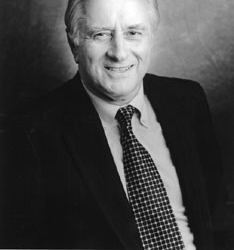
The owners liked and remembered Bernhard…and they had no other potential buyers in the Washington area and as he did play a role in keeping the league in the spring where it prospered, they quickly approved the deal.
A few wondered how Bernhard had come up with the money to buy in, but assumed that he must have some good years or won a lucrative case. Bernhard would reveal the truth in his memoirs.
Turner had suggested the idea of the added half share. The extra $10M of media money would allow Bernhard to recoup the lion’s share of his buy in. Turner would secretly reimburst Bernhard the remaining portion of the franchise cost and the team’s normal share of the league’s TV revenues would pay for the operation of the team on a limited budget in year 1. “It was a crazy time. The commissioner wanted to get to 40 teams so he encouraged the owners to keep the price low so the demand would be there.”
“Add Turner and ESPN pumping money into the league and it had become tough to fail.”
“Ted told me, ‘I need this market and others are scared of it. I want to let you into “the country club” for free. If you maintain a middle of the pack budget, TV alone will pay all of your bills. Mathematically you can’t fail. And if you aren’t into it, just sell after a few years and you’ll recoup everything you invested the first time through as well.’ “
“That was the right environment for me to exorcise the demons from my failure the first time through.”
Turner also had a piece of advice for Bernhard…. “Look at the Redskins’s free agents and sign at least two hard to replace low profile players from the Redskins along with everyone they have cut in the last two training camps. The two guys will keep them mediocre …and that’s what you need to get established. The camp fodder guys will end up filling out your roster and will excite Redskin fans.”
Turner would make this deal as he had a deal in place to acquire a TV station in the DC area for his network and a delay of a year could have hurt that effort.
The team would again be called the Federals per the advise of Turner. It was a known brand and would have the same logo for the same reason, but this time the team would be known as “ The DC Federals” with a silver, black, and grey color scheme to allow the team to distance from the struggles they had the first time through.

In an April press conference, Bernhard would promise the fans a better product this time. “Last time, I think I overthought it and hired a coach from the “throw it around” CFL because I like passing, but we weren’t tough minded enough or disciplined enough --- We weren’t sound.”
“ I let the community down.”
“This version of the Federals is going to be disciplined, smart, and tough — like the people of this area who keep this country running.”
He would sign a name well known and respected in Washington…former Philadelphia Eagles coach Dick Vermeil.
Vermeil had left the Eagles following the 1982 season complaining of burnout, but was now ready for a new challenge.

The Federals would be very interested in the jewel of the NFL 1990 Plan B free agency pool — Green Bay Packer starting QB Don Majkowski, a former Virginia Cavalier.
Click here to continue to the next post
Click here for previous post
0 notes
Text
81. The 1990 off-season --- Expansion: Team 29: Southwest Area
“Maloof’s folly”
…At least that was the headline to an editorial in March in Albuquerque for the Maloof brothers’ announced Albuquerque team. They questioned the value the team would bring to the league and to the Turner Broadcast Network. They did not know that Turner (Atlanta’s owner) had had regular discussions with Gavin Maloof when Maloof was thinking about selling the Birmingham Stallions.
Turner rubberstamped the Albuquerque franchise so he could use the team’s games to sell Spanish broadcasts to Univision for simulcasts. Turner rightly assumed that all exposure was good, revenue generating exposure that narrowed the gap between the USFL and NFL.
The State and City Governments had agreed to contribute $40M to upgrade UNM’s University Stadium. In the Spring of 1990 an upper deck would be built raising capacity to 40,000 and adding a significant number of luxury boxes and bathrooms. During the Lobos’ 1990 season the crews would return to work as soon as the weeks’ games concluded. They would add new chairbacked seats along the sidelines.
The team acknowleged that building a single upper deck was one of the cheaper ways to get capacity up to where they needed it, but they would be very concerned with the thought than a strongly unbalanced capacity stadium could hurt attendance. A promise was made to the team that as soon as the team hit 30,000 in attendance, the city would build another matching deck raising capacity to 46,000.
The Maloofs would see beyond the state’s relatively small and poor population and instead choose to view the team as a team that all Mexican Americans would support. They knew that with Turner alone providing a $15M per team TV payout, the attendance weakness of the smaller stadium site was no longer a deal breaker.
Merchandise sales in a larger region than just New Mexico would make up those shortfalls anyway. Along marketing lines they liked what the University of New Mexico had done in choosing “Lobos” — spanish for wolves — as their mascot.
“We liked ‘The New Mexico Quetzals’ for a long time.” Gavin Maloof would say years later. “Putting New Mexico in front of anything is a mouthful, but we thought ‘New Mexico’ would be easier for fans out of state than ‘Albuquerque’, and it puts ‘Mexico’ into the name. ‘The New Mexico Quetzals’ sounded about right…. But ultimately it was a bird and we wanted something more attention grabbing.”
“When someone suggested “Chupacabras” we knew that was it.
“The New Mexico Chupacras” is a mouthful, but it is totally Mexican, with just the right amount of Macabre to be cool.”

The team would hire former Dallas Cowboys QB and Denver Gold head coach Craig Morton.

Morton had been fired after his Gold team had collapsed under injures including the loss of their QB Craig Penrose, but it wasn’t lost on Maloof that the player’s coach Morton had a .500 record in the USFL over a season and a half and there was every reason to believe he would have had a better record if Penrose hadn’t been injured…..and if the Gold ownership hadn’t traded away Denver’s two best linebackers in the pre-season in a cost saving move.
“I knew that .500 was our magic number. If you can get around that in football, you give fans hope and they come to games. Everyone wants to win the title every year and I am no different, but with 29 teams that wasn’t going to be a realistic annual dream. We just didn’t want to be bad. A team within sight of a 500 record each year was a realistic goal and we thought Morton was the guy to get us there.”
Morton would encourage the team to try to acquire veterans from Denver, Arizona, and San Antonio and to specifically try to acquire the rights to all the former Air Force stars from the 80′s teams. Morton would make the case that New Mexico USFL fans were currently fans of Arizona, San Antonio, or Denver, so any signings off those roster would have positive PR gains as well as filling playing roles on the team.
He also encouraged the team to look into former Dallas Cowboys.
There was a logic to his thinking. He knew first hand how the Gold had drawn well by signing former Bronchos players. There was no NFL team in New Mexico for him to cull players from. The smartest course of action in terms of building fans was to pull as many college players as possible from the team’s territorial assignments, the University of New Mexico, New Mexico State, UTEP, Texas Tech, and Air Force, but talent from those schools would not fill a roster.
Air Force’s collection of 1980′s All-Americans would be some of the best talents produced by those universities. With New Mexico’s large military personnel in state, securing those players from the academy who had signed with Denver would be a priority along with acquiring former UNM star WR Terance Mathis.
Morton needed quality veterans. He knew many of the Gold players and knew which ones he could work with.
San Antonio was coached by his former NFL head coach, Tom Landry. He knew how Landry operated, had friends in the Gunslinger organization, and respected the way Landry developed talent.
He also had some insights into the Wranglers organization.
These ties would serve him well as he quickly ramped up the team’s talent level.
The Chupacabras would be team 29.
Click here to continue to the next post
Click here for previous post
0 notes
Text
80. The 1990 off-season --- More expansion on the way…
After a few weeks of the season, the League owners felt their expansion teams the previous year were at a decided disadvantage vs. the established teams. So the owners retreated to a position that had worked in the past....no expansion in the coming year.
As the year progressed they also worried about the stability of the New York franchise.
Ted Turner strongly disagreed on the expansion issue.
Turner firmly believed that once there were more teams in the USFL than the NFL, the USFL would quickly rival and probably surpass the NFL in popularity within a few years given it’s younger demographics. Turner knew when it did, he would have the loyalty of the league in contract extensions for carrying the league from the edge of oblivion. For Turner, the faster the league grew, the better.
Turner argued that counter to the league’s worries, expansion opened up easy wins for the previous expansion teams and sped their fanbase development.
“Targeted expansion can create better, more lucrative divisions,” he argued. Plus as long as the cities were on the approved list, the league would continue to be paid at the going market rate for teams, making it almost difficult to go out of business --- a far cry from the league’s early years.
For the 1991 season, he advised that rate would be $15M per team from the Turner Broadcast Network, almost double the prior year’s payouts (a staggering figure based largely on Turner rebroadcasting the best games of the USFL season in weekly sequence opposite NFL games on sundays in the fall) and $6M per team from ESPN.
With that….and constant coaxing by former owner Gavin Maloof, who wanted to buy back in….by March, the league owners agreed to expand again.
The league would have a number of suitors, but the league leadership would push for certain markets to balance the teams.
Click here to continue to the next post
Click here for previous post
0 notes
Text
79. The 1990 post-season awards
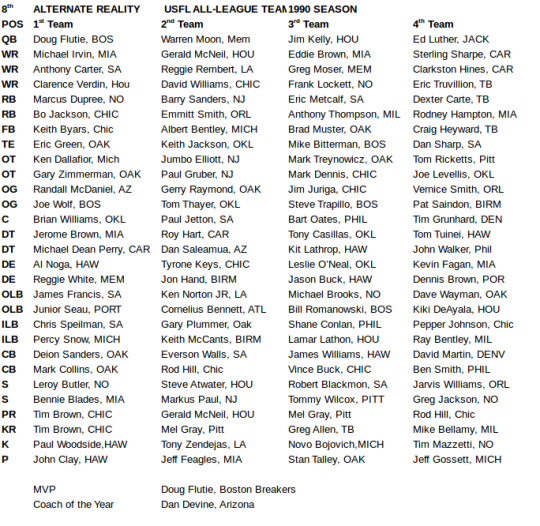
Click here to continue to the next post
Click here for previous post
0 notes
Text
78. The 1990 season
The arrival of the 1990 USFL season was, by most USFL fan and media accounts, the most eagerly awaited USFL season of them all.
What would the league look like without Hershel Walker?
Would the 14 game season eliminate some teams’ late playoff pushes?
How would Tom Landry fare? Would he have a losing season?
How many Yards would Barry Sanders run for this year?......
Final regular season standings

Season Breakdowns

Dick Coury’s team would see everything come together after several seasons of seeming misfires. Doug Flutie and the league’s 4th ranked offense were seamless in their execution and the defense finally seemed to really jell. The Breakers would lead the league in turnover margin. Even their failures worked out great. Fighting back to achieve an inexplicable tie with the last place Generals would actually give the Breakers the division.
Barry Sanders and the league’s #3 offense would prove just as tough to stop in year two, generating a league best 1753 yards on the ground. While the Knights’ defense was nothing to write home about, few teams could outscore them.
Martyball really started to take hold in Philadelphia under new QB Todd Blackledge. The former Steeler Blackledge had won his fair share of games in the NFL, but his stats were generally poor. Martyball called for him to just manage the passing game and only make passes as required. Hiring former Penn State offensive Coordinator Dick Anderson as Blackledge’s QB coach also helped unleashed a better Blackledge than was seen in the NFL. The team focused on what Blackledge did well. A rash of retirements and defections had removed most of the players from the Mora era, but the new Stars played the same kind of smashmouth, never-concede-an-inch, style of play.
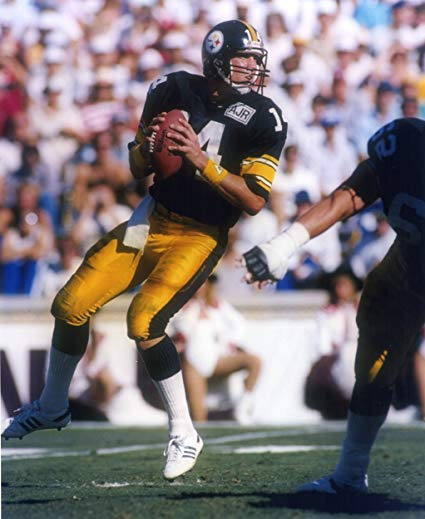
Solid Veteran QB play and dynamic running by small college find Chris Warren had Ted Marchibroda’s plucky Thoroughbreds in most games. Marchibroda’s positivity and toughness bled over to the team. The late season acquisition of Perry Tuttle from Carolina gave fans hope for the following season.
Steve Young got knocked out for the year in the General’s second game and things went downhill from there. The team would lose several veteran defenders as well from a thin roster, leading the team to finish dead last on offense and defense. Team owner Stephen Ross would own the collapse stating the team simply had not spent enough on depth and would promise to rectify the situation, but Michaels, after years of pushing for player acquisitions, took the season personally and would retire at the season’s end.

The Southeastern Division would be a dogfight all year with the 0-2 last place Orlando team (after two blowout losses by a combined 15-86 total in the first two weeks) rallying to rip the division away from Tampa Bay in the season’s final game. The resilience of the “frozen 15″ (15 CFL veterans recruited by head coach/GM Don Matthews), the tough running of Emmitt Smith, the emergence of the Orlando defensive line, the clutch leadership and crunch time play of QB Steve Walsh would take Orlando to it’s first playoff trip and division title.
Fred Bullard’s Bulls were also finally able to exorcise some demons. Finally having fixed the troublesome defensive end positions, Coach John Mackovic’s team was a handful for opposing teams. They would close the season with an easy win over New York to claim a wild card spot.
The Bandits would lead the division until the season’s last game when 8 point underdog Orlando would come back in the last 2 minutes to beat them 20-18 and knock the Bandits out of the playoffs. After the game an enraged Chuck Long would have a private conversation with Steve Spurrier. Two days later Spurrier would have confirmed season long speculation that he would take the University of Florida job, a position he refused to close the door on all season long.
Tampa Bay would not be the only south Division team looking for a new coach. Carolina’s Roman Gabriel would have spent the season under a “playoffs or you are gone” ultimatum and have done a yoeman’s job to get close, even winning the last three games with essentially no QB after Mike Hohenesee went down. Gabriel had won the fans back, but the ownership considered it a matter of protecting their credibility with the fans, so Gabriel was let go after the season. On the positive side, rookie WR Clarkston Hines was a sensation. Initially viewed as a high profile but cost effective potential replacement for Perry Tuttle, Hines proved an upgrade opposite Sterling Sharpe. The rookie showed the same competitiveness he had in college in emerging as a full fledged star.
Last year’s division champs, the Spirits of Miami would enter the last game of the season in control of their destiny. “Win and you are in!” A sign would read in the stadium, as they hosted the desperate and gutted Skyhawks. 60 minutes of game time later, an enraged Michael Irvin would storm off the field, telling anyone who would listen, “This is never going to happen again!” after Vinny Testaverde threw 5 interceptions in a 9-0 shutout home loss. This cap on a very uneven season would be the last game QB Vinny Testaverde would play for Coach Howard Schnellenberger’s team.

With realignment came a new kind of beatdown for the teams of the Deep South division. Having built for years to control the veer running offense of the New Orleans Jazz, no team in the division could begin to compete with pass happy Warren Moon’s “Comets” receiving corps. The Showboats would not only go undefeated in the division, they would outscore division opponents by an average score of 35-15 on their way to a league best 15-3 record.
Leeman Bennett’s Tribe would recover nicely from the week 3 loss of “Zombie Steve” Bartkowski to a career ending shoulder injury. The team had tried hard to sign first round pick Richmond Webb to protect Bartkowski, but after Bartkowski’s loss, Bennett pulled the offer. After a couple of games, longtime backup QB Walter Lewis found his game. He showed he could still scramble and throw but displayed hard gained maturity to his decision making in leading the team to 5 wins in their last 8 games. “Walter has really made me proud this year,” Bennett would confide to the media after the season. “...His career hasn’t gone like he’d hoped and sometimes when a player falls into a backup role they let go of the edge to start. He didn’t. As a coach, those are the players you covet having on your team.”
“How the hell did Charlie Pell win 7 games with this team?” was a constant refrain among local media in Birmingham. The sentiment was shared nationally as Pell would win the coach of the year award, narrowly defeating Ted Marchibroda. With no proven QB and an injured starting running back, Birmingham fans really couldn’t ask for more.
The unfortunate turn of events with Reggie Collier’s off the field troubles would force the team to release him after the team’s second game. An injury to Marcus Dupree a week later would doom the Jazz’s season. The ownership was ready to commit to rookie QB Tommy Hodson of LSU as their new QB. Hodson was not a Veer QB, so Bobby Collins was released after the team’s final game. Collins could see the writing on the wall when the team released veteran RB Buford Jordan.

With Memphis gone to the east, the assumption was Mike White’s Blitz would literally run away with the division. While they did win the division, it wasn’t easy. White’s team seemed to grow into a mature team this season, but the resurgent Mauler and Panther squads and the shockingly well coached Visogoth team refused to let the Blitz pull away.
For the first time since Jim Stanley was in town, the Panthers seemed on point. The offense, while still not producing at a level the talent would suggest, was consistent and the defense was, frankly, a little mean. Percy Snow brought a toughness the league had not seen since Sam Mills left. The new Panthers played a lot more like the old Jim Mora Stars.
What happens when you mix an upbeat QB whispering head coach in Hayden Fry with a small school star QB with textbook talent and a relentless runner with a deep gear? You go .500 in your first season. John Freisz would have a great rookie year, but Anthony Thompson would be the team’s featured player on ESPN with several very long runs.
White the Visogoths and the Blitz were some of the showiest teams in the league, Al Saunders worked to put his own stamp on the Maulers. Primadonnas were shipped out. Saunders wanted a team as tough as the city and you could seen that thinking in the evolution of the team. Like the team, QB Vince Evans wasn’t the best QB in the league, but he competed each week. The Maulers weren’t going to blow anyone out, but they weren’t ceding an inch anymore that the opponent didn’t earn.

Jack Pardee would be delighted to see Tom Landry in the division. “Rivalries sell” He would tell minority owner Jerry Argovitz when asked about Landry. “ I am going to enjoy beating San Antonio a lot more this year.” The season opener against the Gunslingers would feature a hard fought first half with the teams going in to the lockerroom tied at 10, but the Gamblers would roll in the second half beating Landry’s team 45-10 after throwing deep to score with 30 seconds left. The rematch in the season’s final week would have Landry’s team controlling the clock and grinding out a 32-27 win to finish at 500. That was probably the most drama Houston had this season, winning the division by one game rather than two. Todd Fowler would be a welcome replacement for Ickey Woods.
Division newcomer Arizona was able to use their new rivals’ unfamiliarity with their personnel and schemes to earn the division’s second playoff spot. The strengths of the team were the clutch play of Alan Riser and their defense led by a strong secondary. The 5 back secondary was not that great of an asset in their old division, but in this pass heavy one, it threw off a lot of their opponents.
Tom Landry had been pidgeonholed as being predictable in Dallas, but his Gunslingers were an explosive mix of the familiar and the bizarre and new. Offense coordinator Danny White brought back all of the Cowboys’ pre-snap motion and mixed it with elements from consultant Marv Levy’s old Chicago offense. Given the team’s personnel, it was trying as on each play you didn’t know if you were facing a split backfield, an I formation, or an ace spread set. With the cerebral White calling plays proven veteran WRs Anthony Carter and Ray Alexander outside, dangerous TEs Dan Sharp and Doug Cosbie inside and Eric Metcalf, James Grey, and Johnny Bailey, three of the fastest, most explosive backs in the league all able to run from the backfield or shift to the slot, the Gunslingers were impossible to consistently thwart. Defensively, Chris Speilman and James Frances were dominant. They were so instinctive that playing 3 CBs on most plays never hurt the team vs. the run. Under tackle John Randle was as dominant as Randy White and the secondary was constantly aware of what their opponents were trying to do. If only their QB’s were more accurate... Billy Joe Tolliver was a hard throwing deep ball man, which worked great at times with Carter, but his inability to consistent make the plays in short yardage was the team’s glaring weakness. The team went with Veteran QB Craig Penrose for the most part. He was still solid, but there was a general perception that his play was somewhat conservative and with it’s deep speed, the team was leaving points on the field.
June Jones coached the season under a “playoffs or you are gone” ultimatum. Doug Spedding had no desire to do that, but his fans were starting to tune out. Spedding believed in the Run and Shoot and had no desire to rebuild his roster for a new coach’s sets, but it was high past time the team should make the playoffs. Spedding felt Jones had maintained the offense and his staff was building a surprisingly tough defense, but at the end of the season the Gold had once more missed the playoffs. Jones was fired. A week later Spedding called his minority owners in the Gold and offered them controlling interest of the team. That would be the end of the Run and Shoot in Denver.
Doug Williams went down in week 4 with the Outlaws tied for first in the division with Houston at 3-1. Rookie backup Mike Gundy had a solid rookie year but the league’s toughest schedule cut the Outlaws no breaks.

The Hawaiians would capture their first division title behind a relentless pass rush and nearly error-free ball by QB Robbie Bosco. “Lorch’s Torches”, the fans’ name for the Hawaii front four, would again lead the league, this time with 56 sacks, 4 more than the runner up. Jason Buck and Al Noga would combine for 32. Some would point to the fact that division foes Sacramento and Portland both had suspect offensive lines, but no one could argue with the results. Bosco’s play was reminiscent of his play in college as he would chip away at opponents with pinpoint passing.
Oakland had thought they would win the title, but as usual with George Allen teams, they were statistically dominant (sporting the league’s best defense and 10th ranked offense) but would lose games they shouldn’t from time to time in the regular season. “George Allen teams say ‘Wake us when the playoffs start’” an Oakland sports reporter wrote to calm distraught Bay Area fans. “Don’t panic.”
Don Coryell would miss the playoffs largely due to his own failures. Sure Christian Okoye did miss 5 games, but that’s football. The real story in LA was the downgrade at QB. Coryell had decided Rick Neuheisel would never be happy with the money the team should pay him and that Neuheisel was not significantly better than his backup Rodney Peete anyway. So to eliminate that disruption and save some cap space he shipped Neuheisel to Baltimore. Peete was ok, but the pass rush of Hawaii got him off his game as well. He wasn’t intimidated, but after a few shots, his mechanics and decision making atrophed. NFL Vet Marc Wilson was looked at as a much more talented player, and he was statistically better, but didn’t do well under pressure. The team had gone 0-2 vs. Hawaii and that was the division. Coryell had hoped to just win a title and walk away vindicated for his struggles in San Diego. Now he was haunted by the thought that he had duplicated the trade that had skunked his Chargers team---he had traded away an irreplaceable part of his machine. He decided he could not walk away until he fixed the problem.
Year one in Sacramento was rough on the field. The defense was undermanned. Well...so was the offense...but at least there were bright spots. The team played well together. While teams like Houston, Denver, and Memphis destroyed them, less potent offenses did not. David Archer flashed leadership and rookie Mike Pringle appeared to be a legitimate feature back.
Portland also had a rough season. Gary Hogeboom looked great in Norv Turner’s Air Coryell Variant, but he still missed a few games due to his reckless style of play. Still, he had by far his best season as a pro. Dennis Brown and Junior Seau were a great 1-2 punch in the pass rush. While Portland didn’t have the personnel to cover anyone yet, the team unleashed Seau as a passrusher and he lead the league in QB hurries by a large margin. Rookie Derek Loville out of Oregon surprised as the team’s leading rusher.
Playoffs
Wild card Weekend

It was a disappointing day for fans in New Jersey as Philadelphia bottled up the league’s leading rusher, Barry Sanders. Sanders would only run for 97 yards on 30 carries. “They were so displined, man...there were just no lanes today. They did a great job controlling our offense.” Sanders would say after the game.
The Bulls exploded in Orlando scoring 2 defensive TDs on their way to a hanging 60 points on the division champion Thunder. After the game coach Don Matthews could only speculate. “I worried a little that we kind of were treating it like we accomplished our big goal in making the playoffs. I guess I was right to be worried.”
Oakland would be the third home team to lose in the playoffs opening run as Alan Risher threw a 6 yard pass with no time left. George Allen, Risher’s former coach, spoke to Risher after the game in an episode that the media caught. Risher laughed exuberantly. The press would later ask Allen wha he told Risher. “I told him, ‘This is why we don’t invite you to the playoffs.’ “ Allen would later say. “That kid has a little Joe Montana in him.”
Hawaii would have no trouble with Michigan. Their defensive line would harass Jim Harbaugh and control the Michigan running game.
Divisional round

Jim Kelly would face all cameras after yet another close loss in the teams’s opening playoff game. A reporter would ask if Kelly was surprised by the fact Alan Risher engineered the winning drive and Kelly would immediately shoot that down. “Alan is one of the best in the league in close games. No one likes playing Alan. Arizona had a great gameplan for us. Credit to them.”
Another week, another Hawaii playoff win. The Hawaiians defensive line lead by Al Noga simply dominated the the Blitz offense.
Warren Moon was ready for a shootout. “I watched the game last week and saw what Ed Luther did to Orlando. That defense is loaded with veterans and he just carved them up. There is no quarterback hotter than Ed right now. I told my guys that this will be a shootout and if we don’t play our best we were going to lose. Luckily we came to play.”
Boston’s defense totally shut down the Stars offense as the Breakers rolled to a 28-0 win.
Conference Round

The matchup between the league’s best two regular season teams would live up to it’s billing as the lead would change five times before Doug Flutie would put the game away with 3 minutes to go.
Hawaii would have no answer for Alan Risher’s short passing attack or for Arizona’s defensive scheme.
Championship Game

With 2:18 seconds to go it appeared that Boston had put away Arizona, going up 17-10...but Alan Risher had other ideas. In front of a decidedly Pro-Wrangler crowd in Anaheim Stadium, He lead his team 62 yards in 131 seconds to tie the game up.
Arizona received the opening kickoff in OT and Devine caught the Breakers napping. Risher unleashed a bomb to a streaking RB Kevin Nelson for a 72 yard TD on his first play to win the game.
After the game Risher finally spoke to the media after about the controversy about the merits of his play after being silent on the matter throughout the playoffs.
“Alan after all the criticism that has been levied against you, how does it feel to be the league’s only two-time championship game MVP?”
“You know, I do have something to say on that.” A jubilant Risher said, “My wife asked me to tell her co-worker Ed Zimmerman that I am....NOT.... the 24th best starting QB in the league. ...I am at least 23rd!”
With that controversy resolved, the grinning QB returned to his teammates to celebrate the win.

Click here to continue to the next post
Click here for previous post
0 notes